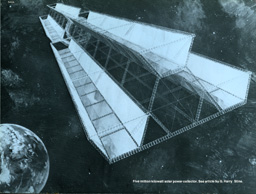![[NAAPO Logo]](../../Images/NAAPOsm.jpg)
North American AstroPhysical Observatory (NAAPO)
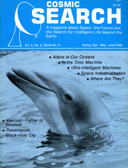
Cosmic Search: Issue 6
(Volume 2 Number 2; Spring (Apr., May, June) 1980)
[All Articles & Miscellaneous Items]
|
Webpage Table of Contents (Bookmarks)
(Internal links to items in this webpage)
[Note. Use Back button (or <Alt>+<Left Arrow>) to get back to this Table of Contents after you have clicked on a link and viewed the article.]
Codes Used Below:
P: Starting page of article in magazine; A: Author(s); T: Title of article
|
The Aliens In Our Oceans: Dolphins As Analogs
By: Bruce E. Fleury
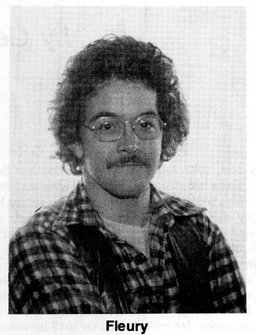
The accompanying article by Bruce E. Fleury is a COSMIC SEARCH AWARD winner — the second to be judged worthy of this honor. The first award winner was Don Lago's "Circles of Stone and Circles of Steel" published in COSMIC SEARCH for March 1979 (vol. 1, no. 2).
While we spin elaborate theories about the nature and distribution of alien intelligence, we generally ignore the presence of intelligent aliens on our own planet, beings which preceded us in evolving a complex brain by over thirty million years.
These terrestrial aliens are the Cetaceans, a large group of marine mammals which includes the whales, dolphins, and porpoises. In several respects, these graceful and curious animals can serve as a useful model for our attempts to communicate with extraterrestrial beings. We are likely to
encounter many of the same types of problems in breaking the communication barrier between human and dolphin that we will discover in attempting to communicate with an extraterrestrial intelligence.
 The intelligence of the dolphin (Tursiops truncates) still remains a matter of some controversy among researchers, but there can be little doubt that the Cetacean brain has reached a level of evolution matched only by the primates. In every area in which gross neuroanatomy has been correlated with intelligence, the dolphin's brain is highly developed. Both their brain and ours, for example, have an extremely intricate cerebral cortex. Although the dolphin's cortex is somewhat thinner, with neurons packed much less densely than our own, its surface is folded and fissured to a
much greater extent than the human brain, providing a vast cortical surface area. The associational cortex, or "silent brain", which is responsible for the most basic human qualities, is large in the dolphin in the very same areas in which ours is larger than the apes.
The intelligence of the dolphin (Tursiops truncates) still remains a matter of some controversy among researchers, but there can be little doubt that the Cetacean brain has reached a level of evolution matched only by the primates. In every area in which gross neuroanatomy has been correlated with intelligence, the dolphin's brain is highly developed. Both their brain and ours, for example, have an extremely intricate cerebral cortex. Although the dolphin's cortex is somewhat thinner, with neurons packed much less densely than our own, its surface is folded and fissured to a
much greater extent than the human brain, providing a vast cortical surface area. The associational cortex, or "silent brain", which is responsible for the most basic human qualities, is large in the dolphin in the very same areas in which ours is larger than the apes.
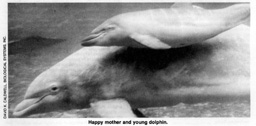 Despite the dolphin's fundamental biological similarity to ourselves, they have evolved into creatures with whom, at least superficially, we seem to have little in common. The dolphin's biochemistry and physiology, however, is much like our own. They are air breathers, warm blooded, and bear live young like any other mammal.
Despite the dolphin's fundamental biological similarity to ourselves, they have evolved into creatures with whom, at least superficially, we seem to have little in common. The dolphin's biochemistry and physiology, however, is much like our own. They are air breathers, warm blooded, and bear live young like any other mammal.
The Cetaceans were once land animals who, in some yet unknown geologic past, returned to the sea and adapted to a new set of biological demands. The oceanic environment demanded a streamlining of form for more rapid movement in a denser medium. The bones on the upper and lower limbs gradually fused, evolving into flukes and flippers better suited to the Cetacean's new mode of existence.
Since the murky ocean depths preclude the heavy reliance many mammals place on the visual cortex in obtaining food, Cetaceans evolved a complex echolocation system, analogous to radar but using sound waves in the water. Sound travels four and one half times faster in water than in air and can travel over much larger distances.
It is entirely possible that this great dependence on sonic echolocation or sonar was the factor that triggered the development of the Cetacean brain. Dolphins are able to make fine sonic discriminations between objects underwater which far exceed the visual acuity of humans. While the dolphin's sonar evolved primarily as an efficient means of hunting prey, the constant presence in the dark waters of the dolphin's mortal enemy, the shark, may also have provided an evolutionary incentive for the development of this highly accurate sonar system.
There is a great deal of evidence that these signals have been adapted from food gathering and navigation to communication. Dr. John C. Lilly, the noted delphinologist, has demonstrated the ability of dolphins, isolated from one another in every respect but sonically, to teach simple tasks to one another. The level of vocal exchanges between dolphins in captivity and in the open sea suggests a highly social relationship between individuals, based on their ability to exchange information in the form of trains of sonic impulses.
We usually refer to the coordination of hand and eye, vital for living in trees, in our attempts to explain the explosive evolution of the human brain. In a similar fashion the neural structures required to transmit, receive, and translate the extraordinarily complex acoustical signals generated by the dolphins may have been the spur to their evolution as a non-manipulative intelligence.
This aspect of dolphin evolution leads us to the first problem in the dolphin/alien example. We tend to associate the use of the hand, especially the opposable thumb, with the evolution of an intelligent civilization. This very provincial prejudice pervades our imaginative literature and much of our research efforts. Man, it is repeatedly said, is the measure of all things.
If the dolphin does have, as Dr. Lilly suspects, a sophisticated culture with an oral tradition, we will have to revise our ideas of what constitutes an intelligent civilization. Dolphins erect no permanent structures, use no tools, possess no science (as we understand it), and are so streamlined as to lack the ability to use the facial expressions and body language we rely on in our own society.
Although we are not accustomed to accepting intelligence in a non-human form, who is to say that the dolphin's water based, acoustically oriented "culture" is not at least as widespread in the universe as our own "manipulatory/visual" one?
Such non-technical extraterrestrial civilizations are presently beyond our reach, since they are probably not able to transmit signals over great distances. Direct communication with them, however, if the opportunity does occur in the distant future, may be not only possible but highly desirable for both species. The dolphin can provide a valuable model for communicating with any non-technical aliens we may encounter.
Although the level of the dolphin's intelligence has yet to be finally demonstrated, the available evidence indicates that it is high, perhaps the equal of our own. The problem will not be resolved until the dolphin's signals are translated. The complexity of these signals, however, has only recently been fully appreciated.
Dr. Lilly has established that the dolphin employs three distinct transmission sources, which can be used separately or simultaneously. The amount of information that can be processed using these simultaneous and independently variable acoustical signals is astounding.
Dr. Lilly's new JANUS project is an attempt to use the microprocessor to construct a device interfacing human and dolphin, and ending at long last the isolation of humanity from a comparable intelligence. He theorizes that their acoustical world may be every bit as rich and as varied as our own visual world. He has demonstrated that there is a definite stereo component to the dolphin's "language" derived from the relative position of two of its sound generating sources around the blowhole. He suspects that they may even be capable of communicating by means of what he calls "holographic sonic pictures".
If this is true, communication between man and dolphin may involve a transformation between their auditory world and our visual one, a transformation likely to test the limits of even our very best computer technology. This type of transformation may also be required to communicate with an extraterrestrial intelligence. We cannot predict what sensory modalities may dominate the evolution of a completely alien brain.
Computer software suitable for contact with dolphins could probably be easily modified to attempt contact with the great whales themselves. The brains of the whales are even larger than those of the dolphins, but they are contained within some of the largest bodies ever to have evolved on Earth.
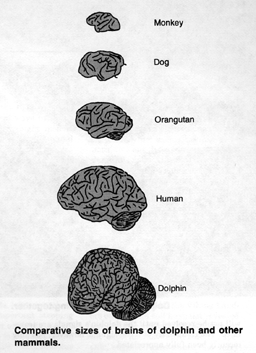 If Dr. Lilly's theories concerning the relationship between brain size and body size are correct, large brains can only exist in large bodies. Dr. Lilly has studied the effects of angular momentum on the head and brain, examining the relationship between the moment of inertia of the brain and of the head and body which surrounds it. The brain has a delicate gel-like structure, and is far more fragile than most people generally realize. This fact limits the brain size that can safely exist in a given body size. Too much rotational acceleration, such as a glancing blow, will literally tear the brain from its blood supply and may even damage its internal structure. The elephant, for example, in spite of its abundant padding, can suffer brain damage or even death from a simple fall.
If Dr. Lilly's theories concerning the relationship between brain size and body size are correct, large brains can only exist in large bodies. Dr. Lilly has studied the effects of angular momentum on the head and brain, examining the relationship between the moment of inertia of the brain and of the head and body which surrounds it. The brain has a delicate gel-like structure, and is far more fragile than most people generally realize. This fact limits the brain size that can safely exist in a given body size. Too much rotational acceleration, such as a glancing blow, will literally tear the brain from its blood supply and may even damage its internal structure. The elephant, for example, in spite of its abundant padding, can suffer brain damage or even death from a simple fall.
The higher density of seawater over air has allowed the great whales to transcend this terrestrial limit, and their brains are, consequently, the largest that have ever appeared on the planet. Their vast bulk, buoyed and cushioned by the dense fluid medium they inhabit, helps protect their large brains from serious injury.
If this theory is indeed valid, a large proportion of intelligent aliens might be massive creatures, who have evolved in a supportive medium denser than air which helps buffer the various shocks and movements of day to day existence. The whale could be an excellent model for the logistical problems of communicating with such beings.
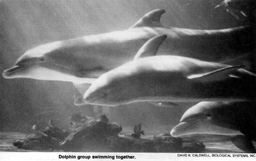 Finally, differences in the physical properties of the medium of communication that might be used by aliens will also present some technical problems. This can be illustrated by the difficulties of communicating with the dolphin across the air/water interface. It is not easy for dolphins to vocalize in air, and even mimic human speech, but they make the attempt with a minimum of encouragement. A major advantage of the dolphin as a model for extraterrestrial intelligence research is its apparent desire to communicate with us. They seem almost eager to interact, and are by nature as playful as they are agile and curious.
Finally, differences in the physical properties of the medium of communication that might be used by aliens will also present some technical problems. This can be illustrated by the difficulties of communicating with the dolphin across the air/water interface. It is not easy for dolphins to vocalize in air, and even mimic human speech, but they make the attempt with a minimum of encouragement. A major advantage of the dolphin as a model for extraterrestrial intelligence research is its apparent desire to communicate with us. They seem almost eager to interact, and are by nature as playful as they are agile and curious.
Fortunately, they do not use their great strength against us when we enter their environment. A dolphin is fully capable of killing a shark by ramming it at high speed. Despite our wholesale slaughter of the great whales and the indiscriminate massacre of the dolphin by the commercial fisheries, dolphins have made no attempt to revenge their species.
This fact may indicate an advanced ethical system which is shared on a planet-wide basis. It is by no means likely that another intelligent race would be as quick to forgive such outrageous treatment, or allow itself to be subjected to performing the circus acts we teach "trained" dolphins to perform.
Captive dolphins may be valuable as a reminder to land bound humans of the dolphin's presence on the planet, and of the need to protect Cetaceans from ultimate extinction, but will we inadvertently cage an intelligent alien race simply because it does not display intelligence in a form we readily recognize? Will we injure or exploit such creatures because of their inability to communicate in a human fashion?
In our search for extraterrestrial intelligence we must be prepared for, and even expect, great dissimilarities both in alien biologies and in the very nature of intelligence itself.
The dolphins and whales can serve as useful analogs for our hoped for communication with an extraterrestrial intelligence. They live in a medium with physical properties different from our own. They navigate, communicate, and may even think in terms of a different sensory modality, and some Cetaceans are so large as to present a unique communications problem in their own right. In addition their language, if such it turns out to be, is far beyond our ability to decipher without the aid of highly sophisticated computer technology.
Our success or failure in communicating with these unique and fascinating creatures can help us to an increased awareness of our ability to communicate with any "off world" aliens we may encounter. Learning to communicate with the dolphin could teach us many of the technical skills we will need, and present many of the same problems we may have to face in communicating with an alien intelligence.
Ultimately, communicating with the aliens in our oceans may teach us much about our ability to accommodate our philosophy and our ethics to the presence of a non-human intelligence.
References for further reading:
David K. Caldwell and Melba C. Caldwell. "The World of the Bottlenosed Dolphin", Lippincott, Philadelphia, 1972.
Joan McIntyre (ed.), Mind in the Waters (N.Y.: Scribner's, 1974; San Francisco: Sierra Club Books, 1974).
John C. Lilly, Man and Dolphin (N.Y.: Doubleday, 1961).
John C. Lilly, The Mind of the Dolphin: A Nonhuman Intelligence (N.Y.: Doubleday, 1967).
John C. Lilly, Communication Between Man and Dolphin (N.Y.: Crown, for Human Software Inc., 1978).
Jacques-Yves Cousteau and Phillipe Diole, Dolphins (N.Y.: Doubleday, 1975).
Deborah Truitt (comp.), Dolphins and Porpoises: A Comprehensive Annotated Bibliography of the Smaller Cetacea (Detroit: Gale Research Co., 1974).
William K. Whitfield Jr., An Annotated Bibliography of Dolphin and Porpoise Families Delphinidae and Platanistidae (Florida Dept. of Natural Resources, Div. of Marine Resources, St. Petersburg, Florida, January 1971), Special Scientific Report #26.
John C. Lilly, "Cetacean Brains," Oceans 10:4-7 (July 1977).
John C. Lilly, "Rights of Cetaceans Under Human Laws," Oceans 9:66-68 (March 1976).
 Bruce E. Fleury has just received his master's degree in Library, Media and Information Studies from the University of South Florida (USF) in Tampa. Born in Malone, New York, in June 1950, he did his undergraduate work in General Science and Psychology at the University of Rochester receiving a bachelor's degree in 1971. While at USF he served as student representative on the board of the University's Library Associates, a group of friends of the library.
Bruce E. Fleury has just received his master's degree in Library, Media and Information Studies from the University of South Florida (USF) in Tampa. Born in Malone, New York, in June 1950, he did his undergraduate work in General Science and Psychology at the University of Rochester receiving a bachelor's degree in 1971. While at USF he served as student representative on the board of the University's Library Associates, a group of friends of the library.
Fleury is an amateur astronomer and skin diver. As an expression of his great interest in the sea, he has worked with the librarian at the Newfound Harbor Marine Institute on the Florida keys. An article written by Fleury with Dr. Fred Pfister of USF on "Student Book Collection Contests in American Colleges and Universities" is appearing concurrently in the May 1980 issue of College and Research Libraries. Fleury has a special interest in academic libraries and scientific reference work.
|
I think all animals think. But that again becomes a matter of definition. Some people who would want to put animals into a separate category feel they think, but not on the level of humans. But man is pretty egocentric about these things. He doesn't think anything corresponds to or thinks like him, and that's probably true. But that doesn't make them a lower form necessarily. Maybe they haven't been able to conquer the earth and overcome environmental difficulties and fly airplanes and all that sort of thing, but in another sort of way they seem to do very well. They are free.
Peter Morgane,
in "Mind in the Waters".
|
|
|
Marconi
By: George H. Brown
 Rarely has an invention captured the public imagination like Marconi's wireless did at the turn of the century. We now call it radio, but then it was wireless—Marconi's wireless.
Rarely has an invention captured the public imagination like Marconi's wireless did at the turn of the century. We now call it radio, but then it was wireless—Marconi's wireless.
After Marconi received the first trans-Atlantic radio signals at St. John's, Newfoundland, in December, 1901, and later, after the value of wireless at sea had been dramatized by the S.S. Republic and S.S. Titanic disasters, Marconi was regarded with a universal awe and admiration seldom matched. Before wireless, complete isolation enshrouded a ship at sea. Disaster could strike without anyone on the shore or nearby ships being aware that anything head happened. Marconi changed all that.
In 1894, twenty year old Guglielmo Marconi learned of Heinrich Hertz's pioneering experiments with electric waves, or Hertzian waves as they were then called. Within a few years Marconi had added an antenna and ground, tuned circuits and other improvements and turned what had been a laboratory curiosity into a practical communication system. Marconi became the wizard of the air waves.
—Eds.
On July 24, 1937, four days after the death of Senatore Marconi, I was installing a directional antenna system for Radio Station WSMB in New Orleans. I was sitting beside a road many miles from the transmitter with a pair of headphones and a radio receiver equipped for measuring the strength of the radio signal. Suddenly I heard an announcement of a program to be broadcast—"The Human Side of Marconi"—followed by voices of a number of my friends and professional associates. One of the speakers was H. E. Hallborg, at that time an engineer with RCA Communications. He related that in 1912 he was one of a
group of American Marconi engineers sent to Ireland to study the huge Marconi transmitter near Clifden on the Connemara peninsula. Day after day while they were in the Clifden station, they would see Mr. Marconi come to the station with mysterious packages under his arm. Sometimes these would prove to be a new form of spark gap or a jigger for receiving, and the next step would be to try his device in practice.
One cold rainy night, Mr. Marconi came in quite unexpectedly, having walked several miles from the railway station, but carrying the usual package—this time unusually large. Everyone eagerly watched the unwrapping. It was not a condenser this time or a new magnetic detector, but instead a dozen phonograph records.
"I thought you young men from the States might be rather lonely out here," said Mr. Marconi rather shyly, "so I brought you some graphophone records."
So saying, he placed the first one on the machine and the homesick Americans thrilled to the strains of "Everybody's Doing It Now".
 Seven years after Guglielmo Marconi trudged the dreary miles from Clifden railway station to the transmitter, Mr. John Alcock and Lieutenant Arthur Whitten-Brown were the first men to fly non-stop across the Atlantic in a heavier-than-air machine. On their way to London, their Vickers-Vimy biplane crashed in a bog in front of the Clifden station in County Galway. On that fateful day, June 15, 1919, the Marconi operators rescued Alcock and Brown from the wreck, served them tea, and sent the news
to the outside world by Clifden's direct land line to Marconi's London Office. I have seen a photograph which shows Alcock and Brown rather grimly contemplating the prospect of a trip in a railcar on the Marconi light railway from the wireless station across the peat bogs toward Clifden. Apparently Senatore Marconi became weary of toting phonograph records across the bogs and had made a railroad track available.
Seven years after Guglielmo Marconi trudged the dreary miles from Clifden railway station to the transmitter, Mr. John Alcock and Lieutenant Arthur Whitten-Brown were the first men to fly non-stop across the Atlantic in a heavier-than-air machine. On their way to London, their Vickers-Vimy biplane crashed in a bog in front of the Clifden station in County Galway. On that fateful day, June 15, 1919, the Marconi operators rescued Alcock and Brown from the wreck, served them tea, and sent the news
to the outside world by Clifden's direct land line to Marconi's London Office. I have seen a photograph which shows Alcock and Brown rather grimly contemplating the prospect of a trip in a railcar on the Marconi light railway from the wireless station across the peat bogs toward Clifden. Apparently Senatore Marconi became weary of toting phonograph records across the bogs and had made a railroad track available.
A few years ago, my wife and I, accompanied by two grandsons, set out to see what remained of the historic Clifden transmitting station. After much questioning in Clifden, we finally encountered one elderly citizen who was able to direct us south on the narrow coast road. About four miles from Clifden, we found the bog, unencumbered by signs except one which stated "ROAD NOT SUITABLE FOR MOTOR VEHICLES." Somewhat of an understatement for the two ruts plunged into a lake several feet in depth. In the distance, we spied one concrete tower base and a pile of rust which appeared to be the remains of an alternator. Closer to us was a vertical steel rail about three feet tall, the last remaining relic of the Marconi light railway.
On a nearby hillside stands a white stone in the general shape of an aircraft tail fin, erected by Aer Lingus. This memorial points to a white cairn a mile away in the bog where the Alcock-Brown aircraft landed. In the town, another memory of the aviators stands as the Alcock and Brown Hotel. But not a sign to tell one of the fifteen years when the giant Marconi transmitter linked the British Isles with North America. Two photographs in my old copy of "The Principles of Electric Wave Telegraphy and Telephone" by J. A. Fleming show the huge engine and boiler house, the large condenser house, the giant antennas, and even a commodious residence for the operators. It is a shock to realize that only a concrete block, a steel rail, and a pile of rust remains.
Note: The flight by Capt. John Alcock and Lt. Arthur W. Brown between Newfoundland and Ireland was the first non-stop transAtlantic crossing by an airplane. Although their big twin-engine Vickers-Vimy biplane (a WWI bomber) carried wireless equipment, it was not working when they landed at Clifden, Ireland, on June 15, 1919. Thus, their landfall near the big Marconi wireless station was not a result of radio navigation. Alcock circled the towers of the Marconi station looking for a good place to land and a bog appeared to be the only suitable spot. In the New York Times account on June 16, Capt. Alcock said, "From above, the bog looked like a lovely field but the machine sank into it up to the axle and fell over onto her nose." Alcock and Brown were not injured.
— Eds.
My interest in Marconi's life and career finally led me and my wife to visit Bologna. First, we walked past the Marescalchi Palace on Via IV Novembre where Marconi was born. Then we proceeded to the Villa Grifone which was his boyhood home and where he conducted his first experiments. While we were viewing the mausoleum at the foot of the hill near the road, a caretaker informed our taxi driver that the villa or house was undergoing repairs and visitors were not permitted to enter. The taxi driver did not know what to do with this information for he was no more able to speak English than was the caretaker. When I addressed the caretaker in her own language, she beamed at us and suggested that we drive to the top of the hill to visit the house and take coffee with her. This we did and we found the house being completely refurbished, with a large meeting room being prepared for technical conferences and a laboratory being re-established on the top floor. It is a magnificent building with high ceilings, marble floors, and huge fireplaces. The fields around, on a high plateau, fade off in the distance to a series of rolling hills, affording an excellent location for radio-propagation experiments.
A marble commemorative tablet on the front wall of the house, facing the village of Pontecchio, is inscribed:—
Onore al merito di Guglielmo Marconi il quale in questa casa facendo le prime prove ancora giovanetto col suo ingegno e collo studio invento il telegrafo senza filo nell'anno 1895 ammirato dall'Italia e dall'Europa.
That is to say,
"Honor to the achievement of the young man who, making the first tests in this house and inventing wireless telegraphy in 1895, is admired by Italy and Europe."
Apparently my unpublicized visits to Clifden and to Villa Grifone established me as a pseudo-authority on Marconi for I was invited to speak at the Marconi Centenary Session at the annual meeting of the American Association for the Advancement of Science held in San Francisco during February, 1974. It was a fitting climax to my long time pursuit of lore concerning the Senatore. The speakers were introduced by Signore Egidio Ortona, the Italian Ambassador to the United States, and one of Marconi's daughters, Gioia Marconi Braga, was one of the speakers. When I learned of her participation from an advance program, I anticipated that this figure from the past was likely to appear in a wheelchair. To my surprise, she was a handsome and gracious lady, ten years my junior. The day was made memorable for me when we were invited to have dinner that evening at the home of Marconi's grandson, Dr. Francesco Paresce. During the course of the evening, Gioia made the wry comment that she found the aircraft beacon on a radio tower near her home to be very annoying as the red light flashed through her windows. I felt that she had little cause for complaint since her father had brought radio towers into existence.
Readers desiring more information on Marconi may find the following two books of interest:
"Marconi—The Man and His Wireless" by Orrin E. Dunlap, MacMillan, 1937.
"My Father, Marconi" by Degna Marconi, McGraw-Hill, 1962.
The first book goes more into Marconi's technological achievements while the second reveals more of his personal life.
 George Harold Brown, radio engineer, has contributed greatly in many ways to the benefit of us all. His revolutionary antenna concepts resulted in more effective systems for broadcast stations and his work on heating with radio frequencies was a key step in the processing of plastics. However, he is perhaps best known as the father of color television, being responsible for the color TV system now in use.
George Harold Brown, radio engineer, has contributed greatly in many ways to the benefit of us all. His revolutionary antenna concepts resulted in more effective systems for broadcast stations and his work on heating with radio frequencies was a key step in the processing of plastics. However, he is perhaps best known as the father of color television, being responsible for the color TV system now in use.
Born in North Milwaukee, Wisconsin, in 1908, he attended the University of Wisconsin receiving three degrees from the institution: bachelor's in 1930, master's in 1931 and Ph.D. in 1933. The same year he received his doctorate he joined the Radio Corporation of America, serving at Camden and Princeton, New Jersey, until his retirement in 1973, in positions ranging from Chief Engineer of the Commercial Electronics Division to Vice President for Research and Engineering.
Dr. Brown has received many honors and awards including an honorary Doctor of Engineering degree from the University of Rhode Island (1968), the Edison Medal of the Institute of Electrical and Electronic Engineers (1967) and the DeForest Audion Award (1968). In 1974 he was Marconi Centenary Lecturer of the American Association for the Advancement of Science.
He has long been active in boy scout affairs, serving on the executive board of the George Washington Council of the Boy Scouts of America (BSA) and is the recipient of the Silver Beaver and Silver Antelope awards of the BSA. He is author of numerous articles in scientific journals and is coauthor of the book "Radio Frequency Heating". Recently, Dr. Brown has completed the manuscript for a book on some highlights of his extremely productive career.
|
|
Letters*
By: Editors
*Letters are always welcome but owing to the volume it is not possible to acknowledge all of them. Also due to space limitations we reserve the right where necessary to condense or edit the contents. Letters may be addressed to: Editorial Dept., COSMIC SEARCH, P.O. Box 293, Delaware, Ohio 43015.
I am one of your first subscribers and, like all others, look forward eagerly to each new issue. In fact I read many of the articles several times.
G. W. Drake
Bay Village, Ohio
I subscribe to too many magazines as it is but COSMIC SEARCH is unusual. It is GOOD!!
Reid Martin
Tavares, Florida
COSMIC SEARCH is doing a fine job of giving an overview of the work being done to explore the possibilities of communicating with possible civilizations beyond the earth. Basic to such communication is the use of the radio telescope.
I am presently building a two-dish interferometer for 610 megahertz and would be interested in exchanging technical information with other amateurs who are working on radio telescopes. I think it would be a good idea for COSMIC SEARCH to include an occasional nuts and bolts article for encouragement to amateurs in the field of radio astronomy.
Jerry Carmean
Calico Ridge
Logan, Ohio 43138
SETI is one of the grandest scientific endeavors and COSMIC SEARCH gives it the serious treatment it deserves.
Bruce E. Fleury
Tampa, Florida
Good luck with COSMIC SEARCH. It is a very worthy effort. The Winter 1980 issue is probably the best since the magazine started.
Prof. Michael D. Papagannis
Chairman, Dept. of Astronomy
Boston University
Boston, Massachusetts
COSMIC SEARCH has excellent material and is very readable. I would enjoy a little more futurist viewpoint.
Robert E. Manion
Columbus, Ohio
We hope radio astronomy buffs will write to COSMIC SEARCH about their work as suggested by Jerry Carmean.
Construction manuals for making your own amateur radio telescope, completely operational radio telescopes and accessories are carried by Bob's Electronics, Fort Lauderdale, Florida. In addition this organization sells a cassette tape with dramatic sounds of pulsars and other radio sources.
—Eds.
We hope your magazine grows and grows. It deserves much success.
Rosina Hodge
Tarzana, California
Publishing COSMIC SEARCH must involve a lot of effort but please continue. It is very worth while.
Dennis Cole
Pasadena, California
Your magazine is something for which I have waited years. Keep up the good work.
Delbert E. Anderson
Laurelville, Ohio
An excellent magazine. I am renewing my subscription for two years.
Flemming Ahrenkel
Horsholm, Denmark
The Fall 1979 issue was very thought provoking.
Louise Sundin
Minneapolis, Minnesota
I find COSMIC SEARCH particularly useful because I can easily understand the articles.
D. Narasimhan
Madras, India
I love COSMIC SEARCH.
E. M. Little
Dryden, New York
|
|
Editorial: Technology and the Future of Our Civilization
By: John Kraus
Our technological civilization has brought about tremendous advances in medicine, food production, communication, computers and transportation. But with it have come the hazards and problems of nuclear annihilation, environmental pollution and rapid depletion of our natural resources.
Technology. we are coming to realize, can be both a Dr. Jekyll and a Mr. Hyde that must be approached and assessed with an attitude of both optimism and pessimism. How can we maximize its good features while minimizing its bad ones? The answers will be both difficult and complex and will require a much higher level of technical awareness on the part of the public in general and the decision-makers in particular.
The future of mankind lies in space. It offers new goals and challenges for mankind's energy and pioneering spirit. Promoting space may at present be difficult but when it has been demonstrated, for example, that an asteroid can be mined at a profit using solar power, everyone will want to get out there and strike it rich. Easterners didn't think much of California until gold was discovered; then there was a mad rush. The same will be the case in space; but this can come only after a first-phase build-up which the space-shuttle "Enterprise" can initiate.
Once started, the exploitation of space in our solar system could become a self-sustaining, wealth-producing enterprise that could completely dominate the earth's economy. The job opportunities are enormous. To get this enterprise going will need more "Enterprises" at a cost of no more than a few nuclear submarines. Spending these dollars on ships in the sky instead of ships beneath the sea can open a whole new, virtually limitless frontier for all mankind.
After the solar system the movement can continue to the stars and the galaxy. But will we be the first or will we find the
galaxy already occupied by other civilizations? We do not know and this is where our present and continuing searches will be of the greatest value.
John Kraus
|
|
Space Happenings
By: Editors
X-rays from the Edge of the Universe
The most distant known object in the universe, quasar OQ172, radiates not only radio and light waves but also x-rays, according to recent measurements with an x-ray telescope aboard the High Energy Astronomical Observatory (HEAD-2) now orbiting the earth.
A team led by Dr. William P. Ku of Columbia University obtained an x-ray picture of OQ172 with the satellite telescope which registered 60 photons from the quasar, a photon being the basic energy packet by which light, radio. waves, x-rays and other
electromagnetic waves are transmitted. Although this is not a large number, it is significant to find that the most distant known object in the universe emits x-rays as well as longer wavelengths with their correspondingly lower energy photons (see
"ABCs of Space," part B, page 32). This information will be helpful in improving our understanding of the nature of such distant quasars.
The quasar OQ172 was discovered in 1969 during the Ohio State University Radio Observatory sky survey at 21 centimeters wavelength. Its great distance of 14 billion light years, close to the "edge" of the universe, is inferred from its rapid velocity of recession (91 percent of the velocity of light) associated with the enormous Doppler shift of its radiation to longer wavelengths (redshift value of 3.54). See "ABCs of Space," Part C in this issue on page 35. For an explanation of the Doppler or redshift see "ABCs of Space," Fall 1979, Part A, page 25.
Quasar Outburst Observed
Quasar OV-236 has been observed in recent years by Drs. Alex G. Smith, Frank F. Donivan and others at the University of Florida, Gainesville, to undergo 10 fold brightness variations but during this time the radio strength has remained relatively constant. Now Dr. William A. Dent and Thomas J. Balonek of the University of Massachusetts, Amherst, report that during 1979 there has been a radio outburst from OV-236 at centimeter wavelengths during which its strength has increased by more than a factor of 3 making OV-236 the strongest known quasar in the sky at wavelengths of about 1 centimeter.
Quasar OV-236 was discovered in 1970 during the Ohio State University Radio Observatory sky survey at 11 and 50 centimeters
wavelengths. A Doppler shift for its emission has not been measured so its distance is uncertain.
|
|
Off the Shelf
By: Mirjana Gearhart
Space, the Future, and the Search for Intelligent Life beyond the Earth have always fascinated Man, as can be seen by the thousands upon thousands of books and articles written since the days of ancient Greece. In this, and future issues of COSMIC SEARCH, selected books and other publications are presented for interested readers. Space prevents inclusion of more than a few in each issue, but we believe that in these references, both old and new, you will find much that will add to your knowledge, understanding and enjoyment.
A. P. French, ed., EINSTEIN, A CENTENARY VOLUME, 1979, Harvard University Press, Cambridge, MA (323 pgs., hardbound). Encompasses the life and achievements of Albert Einstein through the words of his colleagues and contemporaries—men like Edward Teller, Louis de Broglie, George Gamov, Pablo Casals, John Archibald Wheeler and many others. (See COSMIC SEARCH, vol. 1, no. 4, for an exclusive interview with Dr. Wheeler, Father of the Black Hole).
William H. Hartmann, ASTRONOMY: THE COSMIC JOURNEY, 1978, Wadsworth Publishing Company, Inc., Belmont, CA (536 pgs., hardbound). A well-illustrated and well-written astronomy text dealing with all aspects of our cosmic surroundings—from the Big Bang to the Black Hole.
William J. Kaufmann III, BLACK HOLES AND WARPED SPACETIME, 1979, W. H. Freeman and Company, San Francisco, CA (221 pgs., hardbound). The elusive black hole—and its associated geometry—is the topic of this fascinating, well-illustrated book. The reader will find the domain of the black hole stranger than any science fiction.
John Man, ed., THE ENCYCLOPEDIA OF SPACE TRAVEL AND ASTRONOMY, 1979, Octopus Books Limited, London, England (219 pgs., hardbound). This colorful volume is written by noted British astronomers and popular writers. It treats the future of space travel and the impact of yet-to-come discoveries in astronomy—how scientists will be involved in industries unheard of today, how scientists will tackle the significant questions about the Universe, etc.
The National Academy of Sciences, SCIENCE AND TECHNOLOGY, A FIVE-YEAR OUTLOOK, 1979, W. H. Freeman and Company, San Francisco, CA (544 pgs., hardbound). What scientific advances we can look forward to and how they will affect us are two questions asked in this comprehensive study commissioned by Congress for the American people.
Robert M. Powers, SHUTTLE: THE WORLD'S FIRST SPACESHIP, 1979, Stackpole Books, Harrisburg, PA (249 pgs., paperbound). A layperson's explanation of the "Enterprise," how it was conceived, how it will affect man's presence in space. (The "Enterprise" is the space shuttle, tested for the first time by NASA last year.)
Joseph Silk, THE BIG BANG: THE CREATION AND EVOLUTION OF THE UNIVERSE, 1980, W. H. Freeman and Company, San Francisco, CA (394 pgs., hardbound). The general reader will find the story of the Big Bang told in a concise, interesting way.
Gunther S. Stent, PARADOXES OF PROGRESS, 1979, W. H. Freeman and Company, San Francisco, CA (231 pgs., softbound). A controversial volume for readers interested in the interplay of science and philosophy. Stent contends that we are nearing the end of scientific progress.
G. Harry Stine, THE THIRD INDUSTRIAL REVOLUTION, 1979, Ace Books, Grosset-Dunlap, New York, N.Y. (217 pgs., paperbound). A thought-provoking account of what far-reaching implications the industrialization of space can have for mankind.
Ronald Story, THE SPACE—GODS REVEALED, 1976, Harper and Row Publishers, New York, NY (120 pgs., paperbound). Shatters von Daniken's theories on visitors from outer space by providing scientific evidence to the contrary.
Chriet Titulaer, LEVEN OP ANDERE PLANETEN (Life on Other Planets), 1977, Elsevier Publishers, Inc. Amsterdam, Holland (106 pgs., hardbound). This well-illustrated book, written in Dutch, explains the scientific basis for the search for extraterrestrial intelligence.
Ernest H. Wells, SEARCH FOR LIFE IN SPACE, 1975, DeHoff Publications, Murfreesboro, TN (106 pgs., paperbound). A layperson's overview of present-day searches for extraterrestrial intelligence.
|
|
The Chief Entities
By: I. J. Good
 For thousands of years people have speculated about the existence of extraterrestrial life. In ancient times it was thought to consist of gods and angels, whereas devils were thought to be intraterrestrial. Perhaps my own speculations have in some respects an ancient ring, but they are based on scientific rather than religious reasoning. Soon we might obtain some of the answers by direct observation, and then it will be too late to speculate.
For thousands of years people have speculated about the existence of extraterrestrial life. In ancient times it was thought to consist of gods and angels, whereas devils were thought to be intraterrestrial. Perhaps my own speculations have in some respects an ancient ring, but they are based on scientific rather than religious reasoning. Soon we might obtain some of the answers by direct observation, and then it will be too late to speculate.
The problem of defining life has always been of philosophical interest, and on the whole there has been no problem in deciding whether a given entity is alive. But it may become more difficult in the future, owing to advances in cybernetics and biological engineering.
When speculating concerning extraterrestrial life, a definition is required even more. On earth, the possession of DNA as a controlling genetic chemical might be a reasonable defining property, since it occurs in all known lifeforms, but it would be geomorphic to insist on it for extraterrestrial life. Perhaps it would be better to say that a thing is living if its development depends on large molecules containing genetic codes.
A chemical definition of life might be too narrow, and some would feel that a more functional definition would be appropriate. Of the three "self" properties — self-repair, self-replication and self-preservation — the last seems the most important. If a thing is subjected to a great variety of dangers and overcomes them by a great variety of different acts, then it might qualify as a living thing; certainly it would qualify as an "org". (This term was coined in recent years and means an organism or organization.) Perhaps we should insist on both a genetic code and adaptive self-preservation in our definition of life.
It is difficult to agree that any cogwheel machine, however clever it might be, would qualify as living; could it be conscious and capable of feeling pleasure and pain? Maybe any sufficiently complicated information-handling system would be conscious even if it were purely mechanical. But many of us feel, as a metaphysical matter, that consciousness cannot have a purely mechanical basis and must depend on more than Newtonian physics.
Although a reference to consciousness as the main ingredient of life might be considered to be in bad taste by the high priests of materialism and irrelevant to the progress of science, it seems to me to be an issue that cannot be lightly sneezed upon; suppose we find that the back of the moon is inhabited by elaborate cogwheel machines or other orgs judged by us to be robots. If we regarded these orgs as dangerous to human colonization of the moon, we would be tempted to destroy most of them, keeping only a few in captivity for research purposes. We would do so with a much better conscience if we believed they were not conscious. We might do so anyway and learn to live with a bad conscience. Even if consciousness and real metaphysical pain are irrelevant to science, which is doubtful, they are at any rate relevant to ethics, including the ethics of interplanetary politics; but our galactic politics will probably be decided more by fear of retaliation than by ethics, until we reach cosmic maturity.
Ultraintelligent Machines
Real metaphysical consciousness might be relevant to science for the construction of the first ultraintelligent machine. By an "ultraintelligent" machine, I mean one that can do every intellectual feat better than any man. I am inclined to believe that such a machine will be constructed before the end of this century, using advanced electronic and optical techniques. I think the machine could be trained to become independent of its operator, but it is possible that it would not be properly motivated unless the operator remained in control.
The notion of an ultraintelligent machine will be relevant later on, so let us consider it in a little more detail. After the first ultraintelligent machine is built, the designs of far better and more economical ones can be handed over to the machine and its progeny, apart perhaps from some ethical guidance from a human committee. Clearly, there will then be an intelligence explosion. This will lead to extraordinarily rapid advances in medicine, space research, social science, and in every other branch of science.
To say that a man runs like a machine is a compliment; before long it will be a compliment to say that he thinks like one.
It might be objected that machines cannot be expected to be creative. But creativity consists in putting ideas together in an unexpected manner, and once we have analyzed, perhaps linguistically, how ideas can be put together, we can begin putting pairs of ideas together in very large numbers by machine. If we can also solve the problem of testing whether the results are useful, then there will be no obstacle left. People put ideas together faster than is sometimes appreciated especially in the visual system, where it is done without effort. I believe an explanation will be found in the cell assembly and subassembly theories of the mind.
In order to consider how much intelligent life there might be in the universe it is necessary to remind ourselves of its size and some other of its features. First, let us get our distance scale in focus. We are about eight "light-minutes" from the sun — that is, about 150,000,000 kilometers — whereas Pluto, which is the farthest out of the known planets, is about forty times as far; and the nearest star is about 6,000 times as far away again. The diameter of our galaxy is about 20,000 times the distance to the nearest star; in fact it is about 80,000 light-years. The nearest full-size galaxy to our own is about a million light-years away; and the farthest one so far observed is a few thousand times as far away again; in fact its distance is believed to be a sizeable fraction of the radius of the whole "observable" universe.
The universe contains about 1011 (100,000,000,000) galaxies and about 1022 stars—all in immense space. But presumably most space travel by men, during the next fifty years, will be confined to the vicinity of our solar system. Even if a space-ship runs out of fuel and drifts out into the black depths of galactic space, it would take at least 10,000 years to get as far away as the nearest star. One might think, then, that interstellar travel is quite out of the question, but it should be remembered that technology started only a few hundred years ago, and even the human race is only twenty million years old according to the latest estimate. Interstellar travel might be quite easy for a civilization that is old by galactic standards.
Sherlock Holmes once remarked that if only one hypothesis fits the facts, then it must be true, however improbable it was initially. In this spirit some theories have been put forward for the origin of the solar system; for example, the origin was attributed by Jeans and Jeffreys to the near passage to the sun of another star. This theory is initially improbable since the distances between the stars are so great and is no longer generally believed since the gaseous streamers would not condense into planets. An initially much more probable theory is that the sun and all the planets were formed by condensation of a rotating gaseous nebula. Holmes' principle is true but misleading in practice if the only theory you can think of is initially very improbable because the chances are you have simply overlooked something. Holmes himself never overlooked anything, at least that's Conan Doyle's story. At present, the nebular hypotheses are the most popular among professional astronomers.
It used to be thought that nearly all stars were isolated and that the sun was exceptional; but it is now known that about 80 percent of the stars in our vicinity are parts of multiple systems such as double stars, and at least one star has a non-luminous body going round it, as can be seen by variations in the linearity of its path. Now if a planet were associated with a double star it would be unlikely to be a suitable abode for life because the variations in temperature would be great; but the fact that there are so many double stars is indirect evidence for the existence of planetary systems around single stars. Moreover, one star has been noticed whose spectrum is what would be expected if it were surrounded by a gaseous nebula.
The current view is that in our galaxy alone there are probably at least a billion planetary systems. Moreover there is a magnetohydrodynamic theory of the origin of the solar system, due to Alfvén, which, if correct, would imply that most stars of the size of the sun would have similar planetary systems. This theory is not generally accepted since the magnetohydrodynamic equations are too difficult to work with. The fact that a simple rule, due to Titius and known as Bode's law, gives a good approximation to the relative distances of seven of the planets and of the mean distance of the asteroids from the sun is an indication that there is something rather natural about the origin of the solar system. One's first impression that the planets are spread around higgledy-piggledy appears to be incorrect.
Some fifty years ago it was frequently said that life is so fantastically unlikely that it could not have developed anywhere except on earth. In 1850 it was usually assumed that each species required a separate act of creation, and it was dangerous to deny it. The most common view among professional biologists today is that life is very likely to develop when the conditions are right and that no great coincidences are required. This view is further supported by the adaptability of life on earth under a variety of hostile conditions, an adaptability that is at first sight amazing.
Advanced Civilization
The development of life on earth exhibits a tendency to assume forms of greater and greater complexity. Let's call this the "Fourth Law of Thermodynamics", since the Second Law states that isolated physical systems tend to a state in which no work gets done. If a living organism is isolated, the best it can hope for is suspended animation, as in a deep freeze.
In virtue of the Fourth Law of Thermodynamics we can expect a reasonable proportion of planets in our galaxy, where large life-forms have developed, to possess advanced civilizations. (The life-forms presumably must be large, like humans, to have a prospect of great intelligence.) Nearly all the civilizations that have attained a level of technology as advanced as our own "civilization" will have done so many millions of years ago, since a million years is a very short time in comparison with the age of the galaxy.
If a civilization were 100,000,000 years ahead of our own uncivilization it would have invented the ultraintelligent machine about 100,000,000 years ago, unless it were prevented from doing so by a galactic police force. Within 1,000 years of this invention the technology would be unimaginable to us—let alone within 100,000,000 years. Among the inventions made within the first thousand years might well be methods of prolonging life almost indefinitely by the replacement and rejuvenation of parts; or the creation of ultraintelligent life-forms; or the construction of space-ships that could travel with a speed comparable to that of light. The ultraintelligent machines will also have helped to keep the peace and to stabilize the social system. They will create social problems but will also produce the solutions of those problems.
These guesses are too optimistic in at least one respect, since many of these civilizations will have allowed the Second Law of Thermodynamics to win out against the Fourth Law, either through internal strife or because the civilizations became redundant after inventing their ultraintelligent machines. A certain fraction of advanced civilizations will have failed to achieve a planetary government and will therefore of course have annihilated themselves. But there must be a reasonable fraction, say 10 percent at least, where a planetary government was evolved. Of these, some will have become too corrupt to bother about their descendants, and will have used up the natural resources of their planets within a few centuries. But again a reasonable fraction, say at least 10 percent, will be sufficiently forward-looking to avoid this, especially as the individuals will be long-lived. In most cases, ultraintelligent machines will have been built within say a century of the widespread use of electronics and lasers. The collection of ultraintelligent machines would soon have achieved the status of an oracle and its advice would have been accepted even by the most stupid of politicians. Thus united planetary governments would have become established.
It therefore seems safe to assume that a small but by no means negligible proportion of advanced civilizations will have survived. Since there were probably thousands of millions of advanced civilizations in our galaxy, even a small proportion of survivors would be a large number. And
even if there had originally been only 1,000, a figure far lower than most scientists who have considered the matter recently have suggested, probably at least one of them would have survived.
A race of beings, each of whom is almost immortal, would be prepared to plan millions of years ahead and would have been able to colonize the entire galaxy. It would not be necessary for any one being to travel more than a few light years in order that the entire galaxy should be explored. Pioneers from distinct civilizations might have come into conflict, but by now these conflicts would have been resolved, and a stable United Worlds Organization must have been established. Strong evidence for this is the fact that we ourselves have not yet been annihilated by extraterrestrial entities. They probably have evolved an instinct of peace-ability as well as a police force. It is already known that the aggressiveness of monkeys can be controlled by means of electrodes placed in a certain part of their cerebral cortices, so presumably aggressiveness can be controlled even in homo self-styled "sapiens".
In our vicinity the average distance between stars is about ten light years. Near the center of the galaxy it is only about one light year. Hence the population density near the center is presumably about a thousand (10 x 10 x 10) times what it is in our vicinity. (Not 10; space is three-dimensional.) Moreover there might have been a great deal of migration to the center in order to be in the heart of things, just as there is a tendency on earth for people to migrate towards large cities.
 There is little reason to suppose that all the Top Beings would be of the same species. Even if they were all descended from the same species in the first place, they would have had hundreds of millions of years in which to differentiate into a great variety of species and genera—if these terms are not too geomorphic—by the processes of natural selection and artificial selection. So we can assume, with reasonable confidence, that the United Worlds Organization is sympathetic to all forms of life. Perhaps it would be better to talk about the Chief Entities rather than the Top Beings, since they might be machines, or a hybrid between machines and living beings, "biomachines" as it were. Perhaps biomachines would be more sympathetic to all forms of life than purely biological things would be. A biomachine would probably not be much concerned about the color or even the shape of other biomachines.
There is little reason to suppose that all the Top Beings would be of the same species. Even if they were all descended from the same species in the first place, they would have had hundreds of millions of years in which to differentiate into a great variety of species and genera—if these terms are not too geomorphic—by the processes of natural selection and artificial selection. So we can assume, with reasonable confidence, that the United Worlds Organization is sympathetic to all forms of life. Perhaps it would be better to talk about the Chief Entities rather than the Top Beings, since they might be machines, or a hybrid between machines and living beings, "biomachines" as it were. Perhaps biomachines would be more sympathetic to all forms of life than purely biological things would be. A biomachine would probably not be much concerned about the color or even the shape of other biomachines.
If we assume that the universe is populated like this, the next question is: "how would the universe be colonized?" Space travel might be extremely boring, so civilizations could either send out complete villages in very large space-ships, or they could put fertilized ova into deep freeze and then space-ships of moderate size would be adequate. When the ship arrives at a suitable habitat their ultraintelligent machines could thaw out the ova, incubate them, bring them up and educate them. If it were not for the fact of evolution on earth, we could conjecture that Adam and Eve were Top Beings, at any rate before the fall! As it is, it is somewhat more likely that Christ was a Top Being.
It is not essential that all the Chief Entities should live on planets; many of them might live in artificially constructed space stations for some of the time. And these stations would be useful for relaying radio, laser, or other communications. Some of their space-craft might be very small, and be inhabited by pico-micro-miniaturized ultraintelligent machines. An advantage of small space-craft is that they could land on strange planets, such as our earth, and could take off again with a small expenditure of energy.
What experiments should we perform to detect the presence of the Chief Entities? Some radio listening has been tried on a wavelength of 21 centimeters, which happens to be suitable for interstellar communication. These experiments are more pertinent for communication with advanced civilizations as such rather than with the Chief Entities. The Chief Entities will make their presence known when they see fit.
The Galactic Zoo
What then are the Chief Entities waiting for? We have agreed that they have not occupied the earth because they are lovers of peace. Then why don't they announce their existence in order to encourage peace on earth? Perhaps we are part of the galactic zoo and are good material for doctoral theses. If they were to intervene it would bias their statistics. But we should not complain, since it is better to live on a preserve than in a jungle.
There can be little doubt that we have been under regular observation ever since we started using radio. We are in a very interesting and unusual condition, since we are going to build an ultraintelligent machine within the next few decades. Soon after we have done so, the Chief Entities will be forced to announce their presence since we are otherwise liable to become obstreperous. The Chief Entities will have excellent judgment concerning our probable future behaviour, partly because of their unimaginably great intelligence, and partly because of their vast experience of other emergent civilizations. By their experience alone they might know that it is unwise to announce their presence unambiguously to primitive cultures: to do so might undermine our existing motivations for working and lead to chaos. They might be waiting for the ultraintelligent machines to take over, especially if they themselves are machines!
On the face of it, the Chief Entities have an acute problem of communication between themselves, because light and radio signals travel very slowly; one message between two planetary systems would take years. A centralized galactic government would be exceedingly unwieldy if its communications took thousands of years. Thousands of years are not much compared with the age of the galaxy, but if we were left to our own devices for such a time there is no knowing what crimes we might commit in the name of high ideals and undefined abstractions; the real motivation is the unconscious lust for power on the parts of the politicians. Accordingly we can reasonably presume that the galactic government is highly decentralized. It is ancient enough to have developed a fixed but viable constitution, copies of which would be widely distributed. I have assumed for the moment that no informative signals can travel faster than light, as has been generally believed since the acceptance of the Special Theory of Relativity. But there are more things in the universe and in the galaxy than were dreamed of in Einstein's philosophy.
At all times in the history of science a large fraction of professional scientists, in their collective arrogance, have strongly believed that we were close to the whole truth and nothing but the truth concerning the fundamental laws of nature. (Collective arrogance is a kind of trade union activity, is commoner than personal arrogance, is generally considered to be less noxious, but is more so.) Laplace, for example, thought the entire future could in principle be predicted if we knew the positions and velocities of all particles of matter. This form of billiard-ball materialism is
now hotly denied by most quantum-mechanical physicists. The "miracles" that have occurred since Laplace's time, some of which were not even predicted in science fiction, let alone by the professors who wished to be respected for their common-sense administrative ability, include (i) radio and, in particular, transatlantic radio which was declared impossible in a court of law by a professor of physics when it was first claimed by Marconi; (ii) the clock paradox that if you take a round trip with nearly the speed of light you return younger than those who stayed behind; (iii) atomic energy, whose economic use was declared impossible by Rutherford himself; (iv) lasers ("death-rays" were predicted even in bad science fiction); and (v) satellite communication, predicted by Arthur Clarke in 1945, although the British Astronomer Royal said space travel was impossible a few years later.
We might be close to the whole truth in physics, but to believe this with much confidence is entirely unjustifiable. Although quantum mechanics is a very successful theory, its implications are more fantastic than any self-consistent science fiction, and in fact quantum mechanics is probably self-contradictory and therefore strictly wrong. Moreover, there are many simple and important unsolved problems which could eventually be classified under physics; for example, the nature of quasars, why the proton is so much heavier than the electron, the nature of consciousness, and whether telepathy, or instantaneous thought transmission, is possible.
Let us then reconsider the possibility of signalling faster than light. This is not strictly ruled out by the Special Theory of Relativity as is often thought. What this theory implies is that if a signal travels faster than light to one observer, then there will be other observers for whom it travels backwards in time. But several eminent physicists and mathematicians have quite seriously suggested this apparently paradoxical possibility, mostly but not entirely for subatomic phenomena. There is, for example, the Stückelberg-Feynman idea that a positron can be regarded as an electron moving backwards in time. In Gödel's modification of relativity theory, a speed of 72 percent of the speed of light is enough to produce backward time travel. The apparent paradoxes of backward time can be resolved in terms of the branching-universe theory, but I shall not go into details here.
Any evidence for precognition, or knowledge of events before they happen, would be evidence that signals can travel backwards in time. Perhaps the best evidence is not yet scientific because it depends on highly critical emotional situations which can hardly be repeated in a controlled manner. Any evidence for telepathy is weak. But one thing is fairly certain. If telepathy is possible, the Chief Entities would have perfected it by now and I would guess that all the best life in the universe would be now living in a state of integrated consciousness. The consciousness of a man is apparently a consequence of close communication between many entities: we tend to forget that a neuron is an animal that lives in the head.
This article is a revised version of one which appeared earlier in "Theoria to Theory" (vol. 3, Third Quarter, April 1969). Reproduced by permission. The article in its original form was published
in "The Listener", June 3, 1965.
 Irving John "Jack" Good is University Distinguished Professor of Statistics at Virginia Polytechnic Institute and State University, Blacksburg, Virginia, a position he has held since 1967.
Irving John "Jack" Good is University Distinguished Professor of Statistics at Virginia Polytechnic Institute and State University, Blacksburg, Virginia, a position he has held since 1967.
Born in England in 1916, Good received his Bachelor's degree in 1938 and Doctor's degree (in mathematics) in 1941, both from Cambridge University. He was with the British Foreign Office from 1941 to 1945 and was Lecturer in Mathematics and Electronic Computing at Manchester University from 1945 to 1948. Prior to coming to Virginia Polytechnic Institute he was Senior Fellow at Trinity College, Oxford. He is author of a number of books including "Probability and the Weighing of Evidence" (1950) and "The Estimation of Probabilities" (1965), and was editor of the book "The Scientist Speculates" (1962). He is a member of dozens of professional and scientific societies and is a champion chess player.
|
|
In Review:
IS ANYBODY OUT THERE? THE SEARCH FOR EXTRATERRESTRIAL LIFE,
A Harper & Row Media Program by Harper & Row Publishers, Inc., 1976.
Is Anybody Out There? is the title of this well-produced, well illustrated and thought-provoking series of six sound film strips created for Harper & Row by Isaac Asimov.
The film strips cover the entire spectrum of subjects dealing with SETI: the Endless Quest; Life; Rare or Commonplace; Finding Habitable Planets; Have We been Visited?; the Odds on Intelligence; and Will Anybody Answer?.
The series forms an interesting basis for a multi-disciplinary approach to the SETI question. Man's yearning to learn if other planets are inhabited by intelligent beings has existed for thousands of years, yet it is not til now, late in the twentieth century, that he has gained the tools to tackle this profound problem.
Is Anybody Out There? provides students and interested laypersons with an accurate foundation to deal with SETI on a scientific as well as sociological basis. The concept of life as we experience it on earth and as we hypothesize it in space, forms the beginning of an exciting account of seeking planets that can support life forms. Whether life is or is not intelligent becomes perhaps the single most important question in radio astronomers' numerous attempts to receive signals
from extra-solar planets.
This series of film strips is stimulating. It creates an atmosphere, sometimes overly dramatic, to ask some very profound questions.
Mirjana Gearhart
|
Communication with Extraterrestrial Intelligence
Report on International Academy of Astronautics (IAA) 8th Annual Review Meeting at Munich, Germany, Sept. 16-22, 1979.
By: Jill Tarter
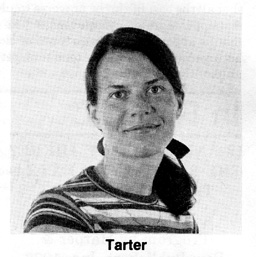 Munich is such a beautiful city and the weather was so brilliant and the beer pastries so delicious that I rapidly forgot about my overly long flight (complicated by hurricane David) and my luggage, which failed to arrive when I did!
Munich is such a beautiful city and the weather was so brilliant and the beer pastries so delicious that I rapidly forgot about my overly long flight (complicated by hurricane David) and my luggage, which failed to arrive when I did!
 This was my first experience with the International Astronautical Federation (IAF) and I was amused to note that the delegates bustled about a bit more than the astronomers with whom I'm used to interacting at international conferences. I did my share of bustling as well; as a substitute for Dr. John Billingham of Ames Research Center, it was my privilege to act as co-chairman of the CETI Symposium along with Dr. Rudolph Pések of the Czechoslovak Academy of Sciences, Prague, Czechoslovakia.
This was my first experience with the International Astronautical Federation (IAF) and I was amused to note that the delegates bustled about a bit more than the astronomers with whom I'm used to interacting at international conferences. I did my share of bustling as well; as a substitute for Dr. John Billingham of Ames Research Center, it was my privilege to act as co-chairman of the CETI Symposium along with Dr. Rudolph Pések of the Czechoslovak Academy of Sciences, Prague, Czechoslovakia.
The CETI Symposium (C for communication instead of S for search) occupied 2 sessions during the 30th IAF Congress. In the morning Dr. Bernard Campbell of the L.S.B. Leakey Foundation, Pasadena, California spoke about the function and nature of terrestrial intelligence charting the formation and growth of undatable memory banks from the most primitive organisms to the present human/digital capability.
Then Dr. Korovin of the USSR read a paper which was to have been presented by Academician Vasevolod S. Troitsky, member of the Intercosmos Council of the Soviet Academy of Sciences. The paper as read was actually the synthesis of two papers which Troitsky himself presented at the SETI Session during the IAU in Montreal this summer. The two main ideas were that there should perhaps be some quantization of the Drake Equation in the sense that life may have been formed in the galaxy over a discrete time interval only and additionally that extremely energetic radio beacons from ETI civilizations are unlikely (Troitsky calls them "Cosmic Miracles"). This latter conclusion follows because construction in orbit in the vicinity of the ETI's home planet must proceed extremely slowly in order to insure that launch of the requisite materials does not become a source of heat/energy pollution for their planetary system.
Dr. Olgierd Wolczek of the Polish Astronautical Society, Warsaw, Poland, followed with a lively discussion of many terrestrial factors such as magnetic field reversal and climatic stability which may have allowed intelligence to evolve on this particular planet. Their absence may have precluded the emergence of intelligent species from multiple life starts elsewhere in the Galaxy.
The morning session concluded with Dr. Charles Seeger of San Francisco State University summarizing the progress which had been made this summer during an American Society for Engineering Education Design Study Program at Ames Research Center. This study group attempted to design a sophisticated signal processor for SETI applications. The design requirements were extreme: 8 million channels of spectral data each second, to be analyzed in as near-real-time as funding allows.
The afternoon session opened with a paper on soft automata by Tibor Ganti of the University of Roland Eotvos in Budapest, Hungary. During the presentation of these ideas on the use of self-replicating, preprogrammed, liquid machines by advanced civilizations wishing to communicate with one another, I detected a singular enthusiasm on the part of one of the delegates in the audience. Therefore I wasn't surprised when Arthur Clarke of Sri Lanka rose to remind us of his own unique speculations along this line in his book "Rendevous with Rama".
Thereafter, it was my turn to present a paper describing SETI observations made in collaboration with Drs. David Black, Jeff Cuzzi and Mark Stull from Ames Research Center, Dr. Thomas Clark from Goddard Space Flight Center and Dr. Frank Drake of Cornell University. We searched 207 nearby solar type stars at frequencies near the 18 centimeter lines of the hydroxy radical (OH) using antennas at the National Radio Astonomy Observatory and at the Arecibo Observatory. Two different schemes were used to achieve high frequency resolution, both of which relied upon high speed tape recorders to collect data for subsequent spectral analysis.
The afternoon session closed with a presentation by David John Richer, of British Aerospace and a student of cybernetics at Chelsea College, University of London. Mr. Richer postulated that an information theoretic approach might help determine a most likely value for "N" (the number of currently communicating technological civilizations in our Galaxy) and in addition assign a meaningful uncertainty to that estimate.
I personally enjoyed all of the sessions of the Congress that I attended. I was delighted to meet Dr. Pések and work with him and the other members of the IAA CETI Committee to plan next year's session in Tokyo. Above all, it was a refreshing change to find myself within an international organization which has long recognized and supported CETI/SETI as a significant and important endeavor.
The only disappointing feature of the meeting was the failure of a large portion of the scheduled Russian delegation to actually attend this Congress. We all would like to know exactly what SETI observations they have completed to date. In the SETI Office at Ames, we receive many Russian papers, but it is difficult to distinguish between proposed and accomplished programs.
 Jill Tarter received a bachelor's degree in engineering-physics (1965) from Cornell University and a master's and doctor's degree in astrophysics (1975) from the University of California, Berkeley. From 1975 to 1977 she held a post-doctoral National Research Council fellowship at NASA-Ames Research Center and since 1977 Dr. Tarter has been Research Assistant for the University of California Berkeley Space Science Laboratory on contract to NASA-Ames Research to do SETI work.
Jill Tarter received a bachelor's degree in engineering-physics (1965) from Cornell University and a master's and doctor's degree in astrophysics (1975) from the University of California, Berkeley. From 1975 to 1977 she held a post-doctoral National Research Council fellowship at NASA-Ames Research Center and since 1977 Dr. Tarter has been Research Assistant for the University of California Berkeley Space Science Laboratory on contract to NASA-Ames Research to do SETI work.
|
Life in the Universe
Report on a Conference of the Council of Europe Organized by the Research Group on Cosmic Chemistry Chemical Evolution and Exobiology at Paris, France, Nov. 19-20, 1979.
By: Jill Tarter

Paris was enchanting, the U.N.E.S.C.O. aides were extraordinarily helpful, the multi-lingual translation services were faultless and as long as the speeches were social or political, everything went smoothly. However, when the scientists attending this conference attempted to address the technical matters which had drawn them together, it was a different story! The audiovisual facilities were hopeless even when they were finally installed. (One slide projector consumed half its weight in plastic framed slides before the meeting ended!)
 Perhaps the most exciting aspect of participation in a conference on "Life in the Universe" is the potential for cross disciplinary exchange; radio astronomers talking with geologists or paleobiologists and chemists arguing points with climatologists—sadly, the opening and closing ceremonies and a fraction of the first morning session were the only opportunities for all the participants to interact. The main body of the scientific sessions ran in parallel precluding the possibility of cross fertilization. The necessity of parallel sessions is a frequent complaint of many meetings, but on this
particular subject, the segregation of different disciplines is self-defeating; next time I'll stay home!
Perhaps the most exciting aspect of participation in a conference on "Life in the Universe" is the potential for cross disciplinary exchange; radio astronomers talking with geologists or paleobiologists and chemists arguing points with climatologists—sadly, the opening and closing ceremonies and a fraction of the first morning session were the only opportunities for all the participants to interact. The main body of the scientific sessions ran in parallel precluding the possibility of cross fertilization. The necessity of parallel sessions is a frequent complaint of many meetings, but on this
particular subject, the segregation of different disciplines is self-defeating; next time I'll stay home!
I do not know what the attendance was at the other two sessions (one on the topic of Planetary Evolution and one on the Origin and Evolution of Life) but I do know that at our session devoted to the Evolution of Intelligence and the Search for Extraterrestrial Intelligence, there were at times only six people in the audience in addition to the speakers! What a shame that the other participants and the local scientific community missed an opportunity to hear and debate the many excellent talks in this session, which was chaired by Frank Drake of Cornell University (and Project Ozma fame).
Cyril Ponnamperuma from the University of Maryland presented several discussions on chemical and pre-biotic evolution on Earth and our attempts to study exobiology elsewhere in the Solar System.
Dale Russell from the National Museum of Canada in Ottawa presented data on the rate of increase in brain-to-body weight ratio over geologic time scales as one indication of the increase in intelligence in terrestrial species.
Bernard Campbell from the L.S.B. Leaky Foundation in Pasadena, California then cataloged the use of tools by animals and hominid species and the development of technology by early man. I spoke about attempts to detect evidence of such technology elsewhere in our Galaxy by summarizing the details of all the SETI searches reported over the past 20 years.
I was also able to compare previous efforts with a specific proposal to NASA for conducting a systematic SETI with existing radio telescopes over the next decade.
Pierre Connes from the CNRS in Paris presented some rationale in favor of an optical SETI and then gave a brief discussion of various promising schemes for detecting extrasolar planets. The capability of detecting Jupiters around nearby stars will exist from the ground and perhaps from the Space Telescope within the decade, however the detection of Earthlike planets by direct or indirect methods requires another generation of space instrumentation.
George Gatewood from the Allegheny Observatory in Pittsburgh then described the photoelectric instrumentation being developed by his group, which allows ground based astrometric observations to achieve milli-arc second precision in minutes rather than in years as has historically been the case.
The session closed with Francois Biraud of Meudon Observatory in France urging the scientific/SETI community to search for some set of orthogonal functions which would describe a waveform which remained completely invariant during traversal of the interstellar medium (a sine wave remains a sine wave, but its frequency can be shifted in transit). Such waveforms, he argued, would be the obvious choice for interstellar communication between civilizations.
As none of us could divine such a waveform, the meeting was adjourned and we went in search of the Beaujolais Nouveau which had arrived in Paris that day. This search, in contrast to some other SETI efforts, was hugely successful! [The "Beaujolais Nouveau" is this year's bottling of local Beaujolais wine, literally "the new Beaujolais".]
 Jill Tarter received a bachelor's degree in engineering-physics (1965) from Cornell University and a master's and doctor's degree in astrophysics (1975) from the University of California, Berkeley. From 1975 to 1977 she held a post-doctoral National Research Council fellowship at NASA-Ames Research Center and since 1977 Dr. Tarter has been Research Assistant for the University of California Berkeley Space Science Laboratory on contract to NASA-Ames Research to do SETI work.
Jill Tarter received a bachelor's degree in engineering-physics (1965) from Cornell University and a master's and doctor's degree in astrophysics (1975) from the University of California, Berkeley. From 1975 to 1977 she held a post-doctoral National Research Council fellowship at NASA-Ames Research Center and since 1977 Dr. Tarter has been Research Assistant for the University of California Berkeley Space Science Laboratory on contract to NASA-Ames Research to do SETI work.
|
Where Are They?
A Report on a Symposium on the Implications of Our Failure to Observe Extraterrestrials
By: Virginia Trimble
'They shall mount up like eagles,' dark-throated assumes,
Cold-sunned, low thunder and gentleness of the authentic Throne.
Vernon Watkins (1906-67)
"Returning to Goleufryn"
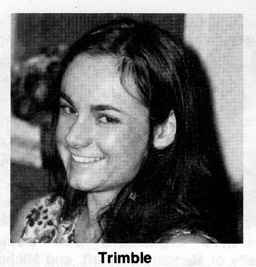 But evidently not to earth, or such was the underlying assumption of the organizers and many of the participants at "Where are They?, A Symposium on the Implications of Our Failure to Observe Extraterrestrials," held at the University of Maryland, November 2 and 3, 1979.
But evidently not to earth, or such was the underlying assumption of the organizers and many of the participants at "Where are They?, A Symposium on the Implications of Our Failure to Observe Extraterrestrials," held at the University of Maryland, November 2 and 3, 1979.
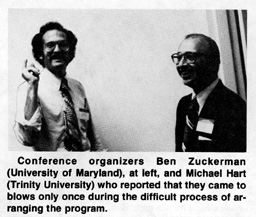 Less poetically stated, the argument goes that if intelligent life had evolved anywhere else in our galaxy, we would already have found out about it, in the same way the Indians of the Americas found out about Spain and Britain—by being colonized. We haven't been colonized (we think) or even received less unambiguous evidence of 'their' existence; hence there is no intelligent life elsewhere in the galaxy.
Less poetically stated, the argument goes that if intelligent life had evolved anywhere else in our galaxy, we would already have found out about it, in the same way the Indians of the Americas found out about Spain and Britain—by being colonized. We haven't been colonized (we think) or even received less unambiguous evidence of 'their' existence; hence there is no intelligent life elsewhere in the galaxy.
The argument so stated clearly has gaps as wide as the Cumberland, and a large part of the symposium was devoted to the question of whether the current absence of evidence for extraterrestrials really is evidence of their absence. Let's look first at various aspects of that question, and then go on to the "implications of absence", like why isn't there any other life, and what should we do about it?
(1) Have we really failed to observe extraterrestrials?
We have almost certainly not been colonized. All terrestrial living creatures, plants, animals, and one-celled creepy-crawlies, share a common biochemistry and (very nearly) a common genetic code, strongly suggesting that we are all descended from a single origin-of-life. We are not half-native, half-colonist. In addition, as Cyril Ponnamperuma (University of Maryland) pointed out, that common biochemistry is very closely linked to conditions in the primitive earth oceans and atmosphere and to the reactions that could occur there, strongly suggesting that our origin-of-life was strictly homegrown. We are all natives of the earth.
Nor is colonization currently in progress. UFO sightings drift in and out of the popular press, but are apparently not relevant to the question at hand. Robert Shaeffer (a free-lance science writer) discussed some of the most widely publicized sightings. They are systematically explicable in terms of IFO's (Identified Flying Objects, like balloons and satellites) or even NFO's (Non-Flying Objects, like mushroom rings and street lights), with a fair-sized helping, in some cases, of human gullibility and craving for fame.
Less spectacular lines of inquiry haven't told us much so far either. Ben Zuckerman (University of Maryland), reporting on searches for electromagnetic radiation (mostly radio waves, but also laser light and infrared radiation from Dyson spheres) from extraterrestrial civilizations, summarized the situation as "nobody has reported seeing anything." He should know, having been one of the two investigators (along with Pat Palmer, University of Chicago) in one of the more extensive searches for patterned 21 centimeter radiation from nearby, solar-type stars. But he has also remarked on other occasions, that, even if he and Palmer had seen something, they might not have told us about it, not being quite sure of the sociological implications of such an announcement. To put the searches so far carried out in perspective, it should be noted that they would fail by a factor of a million to detect the earth as a radio source from a nearby star and could only have seen anything if another civilization had been beaming a very powerful radio antenna directly at them at exactly the right time.
At this level, we have indeed failed to observe extraterrestrials.
(2) If (intelligent) life is common, should we have seen something?
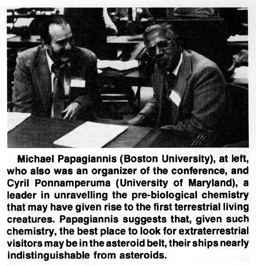 Michael Papagiannis (Boston University) suggested that space-travellers would be so used to life in a capsule that they would never consider settling down on planetary surfaces when colonizing a new stellar system. Rather, they would build additional capsules out of local raw materials and continue to live in them. The most likely place for colonists in the solar system might, therefore, be the asteroid belt, and, as a one-kilometer, self-contained space capsule would not look all that different from a one-kilometer diameter asteroid, somebody may already be out there, without our recognizing them.
Michael Papagiannis (Boston University) suggested that space-travellers would be so used to life in a capsule that they would never consider settling down on planetary surfaces when colonizing a new stellar system. Rather, they would build additional capsules out of local raw materials and continue to live in them. The most likely place for colonists in the solar system might, therefore, be the asteroid belt, and, as a one-kilometer, self-contained space capsule would not look all that different from a one-kilometer diameter asteroid, somebody may already be out there, without our recognizing them.
Why should there be colonists at all? The argument has two pieces, one mathematical and one philosophical. The mathematical part was addressed by Eric Jones (Los Alamos) and Michael Hart (Trinity College). If a civilization (feeling either population pressure or the call of adventure) sends out colonists who settle some place, flourish, and in due course send out more colonists, who in turn—and so forth—then it doesn't take very long to use up all the good planets in the galaxy, including, presumably, ours. The result follows largely from the rapid growth of any exponential function and does not depend very much on details of population growth rate, or speed of space ships, or whatever, provided, of course, that space travel is possible.
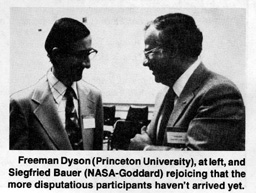 Freeman Dyson (Institute for Advanced Study, Princeton) and Cliff Singer (Princeton Physics Laboratory) discussed a range of interstellar propulsion systems. Some of these are considerably more elegant than the Project Orion method of throwing H-bombs out the back of the ship, for instance, accelerating a spaceship by firing a stream of relativistic particles at it from ground and decelerating it by radiating shock waves into the interstellar medium. The important point is not that any one method is obviously the way to go. Rather, the fact that even our rudimentary technology can come up with a couple of possible ways of crossing interstellar distances strongly suggests that there must be other, better ways available to slightly more advanced civilizations. From a mathematical and technological point of view, then, we "ought" to have been colonized.
Freeman Dyson (Institute for Advanced Study, Princeton) and Cliff Singer (Princeton Physics Laboratory) discussed a range of interstellar propulsion systems. Some of these are considerably more elegant than the Project Orion method of throwing H-bombs out the back of the ship, for instance, accelerating a spaceship by firing a stream of relativistic particles at it from ground and decelerating it by radiating shock waves into the interstellar medium. The important point is not that any one method is obviously the way to go. Rather, the fact that even our rudimentary technology can come up with a couple of possible ways of crossing interstellar distances strongly suggests that there must be other, better ways available to slightly more advanced civilizations. From a mathematical and technological point of view, then, we "ought" to have been colonized.
Sebastian von Hoerner (National Radio Astronomy Observatory) and Ronald Bracewell (Stanford University) addressed the philosophical point: why should a civilization send out colonists in the first place?
This sounds like it ought to be important. We can easily imagine (though not so easily achieve!) an alternative. A civilization might keep its population constant and balance its consumption of energy and raw materials with the rate at which these are supplied by its sun and planet (via processes in the earth generating new ores and so on). Another civilization may blow itself to bits early on, still others become fat and lazy or philosophically rather than technologically inclined. But, says von Hoerner, none of this matters. If, as frequently advertized, a million or even a billion civilizations appear over the history of the galaxy, then the urge to colonize, even if very rare indeed, will surely strike one of them. And, concludes Bracewell, since diffusion is likely to be faster than evolution, whoever is out there first can probably preempt the entire galaxy. Perhaps, then, there really are not any other civilizations out there.
(3) Why are we alone?
The standard scenario from the Big Bang to the birth of President Carter runs: hot, dense early universe — lumps in the gas become galaxies — stars form and make heavy elements (those besides hydrogen and helium, which come from the Big Bang) — second-generation stars that can have earth-like planets — chemical evolution — life — biological evolution — intelligence, technology, and Richard Nixon. Foul-ups might occur at any of those stages. Symposium participants worried about many of them.
(a) Stellar and galactic considerations.
Terrestrial life has required a steady energy source, lots of heavy elements, and lots of time for its development. How common are these necessities? Because the abundance of heavy elements has increased only gradually during the life of the galaxy, it is not immediately obvious that many stars exist that can meet all the needs. There might be old stars deficient in heavy elements and young stars generously endowed with them, but few stars with both time and suitable raw materials for life bearing planets. This would be a comforting answer, allowing us to be among the first civilizations on the scene for straightforward astronomical reasons. Unfortunately, it is apparently not the right answer.
I reviewed recent work by Bruce Twarog and Pierre Demarque (Yale University) on ages and compositions of galactic stars. The average age of galactic disc stars is rather greater than that of our sun (6 versus 4.6 billion years); and most of those stars have heavy element abundances like the sun's to within a factor of two or three. Finally, stars of approximately solar mass, and, therefore, solar energy-output make up at least 10 percent of the galaxy. Suitable stars are evidently common.
(b) Planetary considerations.
Earth-like life requires an earth-like environment. Reasonable minimum likeness might include a solid planetary surface with a protective atmosphere and liquid water (meaning temperatures between 0° and 100° celsius at least some of the time) persisting over a billion years or more.
How common are planetary systems? Frankly, we haven't a clue. Pat Harrington (University of Maryland) summarized the observations by saying that, outside the solar system, we have no evidence for any objects less massive than the smallest stars (about 0.06 solar masses or 60 Jupiter masses). Shiv Kumar (University of Virginia) went still further, suggesting that, since as many as 90 percent of all stars may have binary stellar companions, planets might be very rare indeed. This may be correct, although orbit calculations (for example by Robert Harrington, United States Naval Observatory) show that planets can happily circle one or both members of many binary systems for billions of years. Whether or not they can form in binary systems is simply not known.
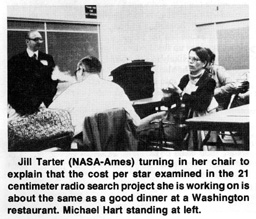 Jill Tarter (NASA Ames) predicted that we will be able to detect planets around other stars (if they exist) within ten years or so and, therefore, need not argue about the issue. Unfortunately, even the most optimistic estimates say that we will be able to see only "Jupiters" and not "Earths" through their effects on the motion of their parent stars. Terrestrial planets may orbit half the stars in the galaxy or only one in a million. We cannot tell.
Jill Tarter (NASA Ames) predicted that we will be able to detect planets around other stars (if they exist) within ten years or so and, therefore, need not argue about the issue. Unfortunately, even the most optimistic estimates say that we will be able to see only "Jupiters" and not "Earths" through their effects on the motion of their parent stars. Terrestrial planets may orbit half the stars in the galaxy or only one in a million. We cannot tell.
Even if terrestrial planets are common, livable ones may be rare. The two dangers are run-away ice ages, in which snow and ice reflect so much of the incoming starlight that they never warm up enough to melt again, and run-away greenhouses, in which everything evaporates and forms a blanket around the planet keeping it too warm for water ever to condense and fall again as rain. The planet's life is made still more difficult by the fact that all sun-like stars get gradually brighter over the billions of years they live, and the planet must survive both the cooler early phases without icing up and the warmer late phases without total evaporation.
Papagiannis and Hart have both calculated the fraction of planetary systems in which at least one planet ought to be able to overcome all these hazards for at least a few billion years. Their answers are one-in-a-million and one in 120, respectively. Our one bit of experimental evidence — that the earth has stayed much the same temperature (as judged from the fossil record) while our sun has brightened some 30 percent over the past few billion years — may suggest even a larger fraction than the latter calculation. Clearly more work is needed.
Given a sufficiently high level of technology, we can imagine transforming unpleasant planets into earth-like ones. The process, as discussed by James Oberg (Johnson Space Center) under the heading 'planetary engineering' is somewhat more complex than dumping algae into the atmosphere of Venus and waiting for them to turn the carbon dioxide into oxygen, but it can probably be done. This would affect the number of planet systems available for colonization, but not the number on which life could initially evolve.
The number of planets on which life can begin is presumably increased if biochemistry very different from our own is possible. Gerald Feinberg and Robert Shapiro (Columbia University) considered some of the alternatives. Water, for instance, may not be the only or even best possible solvent (after all, it keeps trying to break up DNA). Liquid ammonia and liquid silicates could expand the livable temperature range to -50° low and a +1000° celsius high. At still lower temperatures (on planets orbiting red dwarf stars?) information might be stored in arrangements of the two forms of solid hydrogen. And these were two of the more conservative ideas!
In any case, planets, or habitable planets, could be much rarer than is usually supposed.
(c) Biological considerations.
Darwinian evolution (self-reproduction with mutations and selection) is a marvelous way to build up extremely complex organisms with enormous capacity for storing and processing information. But how do you get started?
Hubert Yockey (Aberdeen Proving Ground), Edward Argyle (National Research Council, Canada) and Hart presented calculations of the probability of getting a reasonable protein or a reasonable strand of DNA by assembling chains at random from a soup of amino acids or bases, in the lifetime of the earth. Any such calculation yields a very small number, less than one in a billion billion. Either life is extremely rare, not just in the galaxy but in the universe, or it wasn't done that way. Other ways have been discussed in the scientific literature, though none was presented at the conference. Strangely enough, our existence cannot be used to limit the probability of life very much. If we are unique (in a finite universe) or part of a sufficiently rare class (in an infinite universe) then probabilities like one in a billion billion per star or even smaller are not ruled out by our presence. The author's strong prejudice is that the origin of self-reproduction has a much higher probability and is achieved via a straighter path than random assembly of acids and bases. Laboratory biochemical experiments (of the kind often called Urey atmosphere experiments, in which assorted raw materials like methane, formaldehyde, and ammonia are dissolved in water and fed energy for a while) may eventually indicate one or more possible paths. As Ponnamperuma remarked, he's only been working on the problem for twenty years, and nature had several hundred million; be patient!
Thus the probability of life per habitable planet may be anywhere from one down to the smallest number you care to imagine. In an infinite universe, there will be an infinite number of life forms, no matter how small the probability. But they will be very far away.
Richard Gott (Princeton University) addressed the problem of communication under these difficult circumstances, suggesting that the best wavelength for broadcast and reception may be 5 to 6 millimeters, near the peak of the microwave background radiation, rather than the 21 centimeter wavelength of hydrogen. In any case, dialogue would not be possible among civilizations in different galaxies, as the round-trip message time runs to millions or billions of years.
Finally, of course, it is possible that life, or even intelligent life, may be common, but technology rare. One feels vaguely that the existence of whales and dolphins — intelligent but non-technological species on earth — must somehow be relevant, but it is far from obvious how to use them to estimate the probability of technology occurring among extraterrestrial life forms! Gerrit Verschuur (Human/Dolphin Foundation), who was to have discussed some of these issues, was unable to attend the symposium.
Obviously, our failure to observe extraterrestrials is fully accounted for if life, intelligence or technology are sufficiently rare.
(4) What should we do about it all?
Many of the symposium participants concluded that life (at least intelligent life) is genuinely rare in our galaxy. This is partially a selection effect.
Faithful readers of this magazine will have missed among the named participants many of the best-known advocates of SETI. Still, the non-life (or anti-life) point of view clearly has some justification and is entitled to have its consequences explored. As usual, there are two pieces; deciding whether it is right, and deciding what to do about it.
(a) The future of SETI.
Perhaps the most "anti" statement of all came from Kumar, who, in both printed abstract and talk, "continues to be opposed to expensive programs for search for 'intelligent' life around other stars." His definition of 'expensive' includes the searches now in progress or recently completed. This prompted the author to an envelope-back calculation. The cost-per-star, for instance, of the Palmer-Zuckerman 21 centimeter search or the one now in progress at NASA Ames (described by Tarter) is $10 to $100. At that rate, the cost of assembling the symposium participants, taking them away from their regular jobs for two days, and so forth, would have paid for searching several hundred stars. Perhaps we should all have stayed home? On any less extreme view, clearly the only thing to do is keep looking — if we don't look, we are guaranteed not to find anything! — and keep thinking about the problems between the Big Bang and interstellar travel, some of which have been introduced above.
(b) The future of man in space.
Pogo once looked up at the sky and said, "Either there is somebody else out there, or there isn't. Either way, it's a sobering thought." It is indeed. If it turns out that human life is the most advanced form in the galaxy, then many of us would perceive it as even more valuable than we had previously thought and want to act accordingly. And if we are indeed alone, then we have the opportunity (the responsibility?) to, in Bracewell's words, preempt the galaxy and rebuild it as we see fit. Singer suggests that (if we don't blow ourselves up first) interstellar travel is possible in a hundred years, likely in a thousand, and unavoidable in ten thousand. But he also said that the most important thing is not when we get into space but the quality of life we send there. That is perhaps the right note to end on.
|
Symposium Gleanings
Is the current absence of evidence of extraterrestrials really evidence of their absence?
We are all natives of the earth.
The most likely place for colonists In the solar system might be in the asteroid belt.
Since diffusion is likely faster than evolution. whoever is out there first can probably preempt the entire galaxy.
Even if terrestrial planets are common, livable ones may be rare.
In an infinite universe there will be an infinite number of life forms, no matter how small the probability, but they will be very far away.
It is possible that life, or even intelligent life, may be common but technology rare.
Our failure to observe extraterrestrials is fully accounted for if life, intelligence or
technology are sufficiently rare.
If we don't look, we are guaranteed not to find anything.
Either there is somebody else out there or there isn't; either way it's a sobering thought. It is indeed.
If it turns out that human life is the :most advanced form in the galaxy, then many of us would perceive it as even more valuable than we had previously thought and want to act accordingly.
If we don't blow ourselves up first, interstellar travel may be possible in a hundred years, likely in a thousand and unavoidable in ten thousand.
But the most important thing is not when we get into space but the quality of life we send there.
|

A biographical sketch of Virginia Trimble appeared in the Winter 1980 issue of COSMIC SEARCH (vol. 2, no. 1) in connection with her article "It's a Nice Planet to Visit But I Wouldn't Want to Live There".
[Although the biographical sketch was not reproduced with this article in the magazine, I have reproduced it below from a previous article. — Webpage Editor]
 Virginia Trimble has published research papers on white dwarf stars, pulsars, black holes, x-ray stars and supernovas
and has written many articles, such as "Cosmology: Man's Place in the Universe", "Are Galaxies Here to Stay?" and "The Origin and Abundances of Chemical Elements".
Virginia Trimble has published research papers on white dwarf stars, pulsars, black holes, x-ray stars and supernovas
and has written many articles, such as "Cosmology: Man's Place in the Universe", "Are Galaxies Here to Stay?" and "The Origin and Abundances of Chemical Elements".
Born in Los Angeles, California, in 1943, Dr. Trimble received her Bachelor's degree (Phi Beta Kappa) from the University of California at Los Angeles in 1964 and her Master of Science degree in 1965 and Doctor of Philosophy degree in 1968, both from the California Institute of Technology. She also received a Master's degree from the University of Cambridge, England, and held a post-doctoral position there for two years in the Institute of Theoretical Astronomy.
She has been an Alfred P. Sloan Foundation Research Fellow (1972-76), a Phillips Lecturer (1973), a Sigma Xi National Lecturer (1974-77), the Maryland Academy of Sciences' Outstanding Young Scientist for 1976, the Luce Cosmology Lecturer at Mount Holyoke College (1978) and Phi Beta Kappa Visiting Scholar (1979-80).
Virginia Trimble shares appointments with her husband, Joseph Weber, the gravity wave pioneer, at the University of California, Irvine (where she has tenure) and the University of Maryland (where he has tenure).
Dr. Trimble is in frequent demand at professional meetings and conferences where she has delivered invited review papers on galactic structure, gravitational radiation and other subjects and at colleges and laboratories where she has given many popular talks on a wide variety of astronomical topics.
|
|
Space Industrialization:
Opportunity for Space Science
By: G. Harry Stine
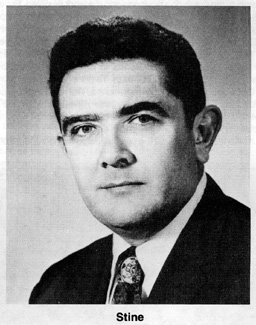 Over the centuries, the historical trend has shown that exploration is followed by utilization. This holds true whether the exploration has been geographical or the purest scientific research. Sooner or later—although decades may be required in some cases—the information garnered from the exploration of the unknown is put to use by people. If the utilization of the information from exploration produces goods or services that are of value to other people, that area of exploration suddenly finds itself the center of attention by entrepreneurs, merchants, engineers, and financiers.
Over the centuries, the historical trend has shown that exploration is followed by utilization. This holds true whether the exploration has been geographical or the purest scientific research. Sooner or later—although decades may be required in some cases—the information garnered from the exploration of the unknown is put to use by people. If the utilization of the information from exploration produces goods or services that are of value to other people, that area of exploration suddenly finds itself the center of attention by entrepreneurs, merchants, engineers, and financiers.
And financiers sign checks.
Some space scientists have loudly criticized the various space programs of the Free World for a general neglect of scientific research in favor of political goals or for the continuing development of nifty technical tricks that seemingly add nothing to the basic cupboard of knowledge. This has continued in some quarters even today on the eve of the launching of the NASA Space Shuttle—a space hardware development that can lead to the industrialization of space.
"You've had your turn with the Apollo and Skylab programs!" these scientists cry. "Now it's our turn! The NASA Space Shuttle must not be used for space industrialization at the expense of space science!"
This is a very short-sighted demand which, if acceded to, could set back space science by many decades.
Reason: American taxpayers have already given the signal that there is a limit to which they are willing to support scientists engaging in what the public perceives as the scientists' favorite hobbies. And they are signalling that the limit has been reached. Congress and the Administration are not deaf to those to whom they must look for re-election or re-appointment.
Having made this charge and given one reason for it, I will justify it as well by showing that support of space industrialization could, as a consequence, offer an incredible number of new opportunities for the conduct of space science with greater ease and at less cost than at present.
For the past decade, a number of people—NASA planners and forecasters, think-tank intellectuals, engineers, and entrepreneurs among them—have started thinking about the Solar System from a quite different point of view.
On the basis of the results of space science to date, the Solar System appears to be useful to us in addition to being a fascinating place in which to seek answers to questions. The utility falls into several areas and includes:
(a) the "high view" of Planet Earth,
(b) unique environmental characteristics such as weightlessness and hard vacuum,
(c) an abundant and renewable energy source (albeit of low energy density in comparison to what we have been used to working with), and
(d) a very large source of raw materials that can be obtained and transported with a low expenditure of energy.
In short: space industrialization.
One aspect of space industrialization alone could be cited in justification, although it doesn't offer a clear-cut case proving the contention. It does, however, have one important advantage: a track record. This portion of space industrialization is the communications/information area exemplified by comsats, earth resources satellites, and meteorological satellites. They exist. Using them we have learned a great deal about our own planet. And with them we are able to communicate directly or by linking our computers together for data processing. I could link the microcomputer on which I am writing this with the NATO computer in London via a communication satellite if I needed additional computing power or memory.
Nobody argues over comsats any longer. Not only have they proven their usefulness by handling more than half the world's communications traffic in 1979, but they have provided a very important additional incentive for more and better comsats: a return on investment.
At this moment, I'm looking at my regular quarterly dividend check from the Communications Satellite Corporation (Comsat). It isn't very much because, in 1964, I didn't have a lot of money to invest in Comsat stock. But it amounts to a total of $2.22 per share in calendar year 1979! As I look at that check, I realize that it is money that was made by using space to provide a service of value to people, including space scientists who got their data back from Pioneer, Voyager, and Viking through the deep space network utilizing comsats for orbital relay of the data because it could not have been done otherwise!
That's just one aspect of space industrialization. Let's take a look at another one that is perhaps still a decade away from realization, but which offers an even more compelling rationale for all-out support of space industrialization by space scientists with their vested interests still foremost in mind. (I have nothing against space science, by the way, having publicly stated in congressional testimony more than once that we should be doing all of it that we can possibly afford to do, plus a little bit more when it comes to unique opportunities such as a Halley's Comet fly-by or a Grand Tour.)
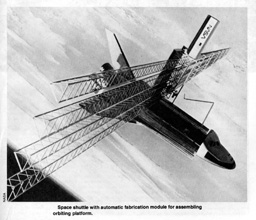 On Earth, we face an impending shortage of energy derived from fossil fuels. Whether we will deplete these fossil fuel resources in decades or centuries is immaterial because we know it will happen eventually. Space industrialization offers us now a very attractive alternative energy resource: the Solar Power Satellite system first discussed in 1968 by Dr. Peter E. Glaser of A. D. Little Co. The Solar Power Satellite (SPS) system is now under intensive study in a joint NASA/Department of Energy program. At this time, there appear to be no technical, engineering, environmental, or financial barriers standing in the way of getting started on a low-cost, low-risk program using the NASA Space Shuttle to check out the critical items of the SPS system. The only barrier standing in the way of doing it is the will to do it. By 1987, we could have answers that would permit a go-no-go decision to build a pilot plant SPS with an output of 5 gigawats. If the pilot plant proves out the hardware and the economics, we could begin constructing 2 SPS units in geosynchronous orbit every year, each with a 10 gigawatt output.
On Earth, we face an impending shortage of energy derived from fossil fuels. Whether we will deplete these fossil fuel resources in decades or centuries is immaterial because we know it will happen eventually. Space industrialization offers us now a very attractive alternative energy resource: the Solar Power Satellite system first discussed in 1968 by Dr. Peter E. Glaser of A. D. Little Co. The Solar Power Satellite (SPS) system is now under intensive study in a joint NASA/Department of Energy program. At this time, there appear to be no technical, engineering, environmental, or financial barriers standing in the way of getting started on a low-cost, low-risk program using the NASA Space Shuttle to check out the critical items of the SPS system. The only barrier standing in the way of doing it is the will to do it. By 1987, we could have answers that would permit a go-no-go decision to build a pilot plant SPS with an output of 5 gigawats. If the pilot plant proves out the hardware and the economics, we could begin constructing 2 SPS units in geosynchronous orbit every year, each with a 10 gigawatt output.
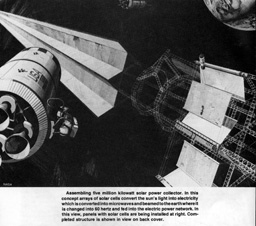 To insure that everyone is brought up to the same level here, an SPS would be a very large array of photovoltaic cells some 5 by 8 miles in extent located in geosynchronous orbit. The incident solar radiation it converts into electricity is then beamed to Earth by one of two means:
To insure that everyone is brought up to the same level here, an SPS would be a very large array of photovoltaic cells some 5 by 8 miles in extent located in geosynchronous orbit. The incident solar radiation it converts into electricity is then beamed to Earth by one of two means:
(a) a microwave beam operating at about 4 gigahertz, or
(b) a laser beam generated by direct solar pumping of several high-energy lasers in parallel.
At the moment, the laser beam seems to be the winner; last year, it was the microwave system. This is one reason that actual on-site tests need to be made in orbit. On the ground, the microwave system would utilize a "rectenna" approximately 10 x 15 miles in extent—depending upon its latitude—where the microwave beam is converted into the voltages and frequencies compatible with the local electric power grid onto which the rectenna output is switched. Laser beaming would use smaller "receivers" that would together cover about the same ground area.
Careful studies to date by several think-tanks working in co-operation with several large utility companies indicate that a 10 gigawatt SPS could be built in geosynchronous Earth orbit for approximately $2000 per kilowatt, which is what it will cost in the 1990 time period to build a coal-fired electric plant of the same capacity on Earth. Electricity provided by an SPS system built from materials hauled up out of Earth's deep gravity well has been estimated at about 27 mils per kilowatt-hour.
In 1975, the total US electric energy demand was 228 gigawatts; by the year 2000, this will grow to 940 gigawatts. So no matter what we do, we are going to have to spend $2000 per kilowatt to build power plants to supply that demand ... or the lack of energy will precipitate a gradual collapse of our social institutions, the more complex and recent ones in the international area being the first to disappear, leaving us staring at each other with our fingers on nuclear triggers. We'd better build those generating systems one way or another.
Question: Shall we build them on Earth with known technology using a fossil fuel source that pumps more radioactive carbon-14 up the stacks than ever leaked from any nuclear power reactor? Or shall we build them at the same cost per kilowatt in space utilizing a renewable energy source? Fish or cut bait; we must get the electricity somewhere.
By the year 2000, coal-fired plants may be competing for coal allocations and facing even stiffer environmental controls.
By the year 2000, we could have 26 SPS units on line carrying more than one-fourth of the US base-load.
Item: The cost of building the SPS system includes the cost of a very large and inexpensive space transportation system capable of placing payloads in low-earth orbit for less than $10 per pound. This space transportation system also makes it possible to begin utilizing extraterrestrial materials in the year 2000 and after to build additional SPS units at about one-fourth the cost of building them with earth-launched materials.
No, we do not have to continue building SPS units ad infinitum because the cheap, ubiquitous space transportation system then allows secondary industry—manufacturing—to follow the energy sources into space where the energy to operate these industries will be cheaper ... in addition to the other space environmental factors that appear to make space manufacturing so attractive. Since more than 60 percent of the US electric power output is used by industrial operations (less than 40 percent of the electricity in the US is used for domestic and civic heating and lighting), this offers the attractive consequence of actually stabilizing or lowering the electric power consumption of the US.
With an SPS system on line in geosynchronous Earth orbit in the year 2000, what are some of the consequences?
1. We can stop building coal-fired electric plants and begin to use coal and other fossil fuels in a more rational way as chemical feedstocks that may be recycled; combusted fossil fuels can't because once they're up the stack, they're gone.
2. We can shut down the nukes because our base-load is being picked up by the SPS system. This one factor alone should generate a considerable level of grass-roots support for an SPS system, judging by the growing anti-nuclear activity.
3. We will have available a big manned space transportation system and a space habitation system consisting of a wide variety of orbital and other facilities all bought and paid for that will lift space scientists and their equipment into space for one-thirtieth of the current cost ... and as often as they want to go, riding on the coat-tails of space industry ... and taking them out as far as the planetoid belt or even to the moons of Jupiter by 2010 to 2020.
Moral: If you want to do space research—lots of space research—better support a program that will produce a product or service from space that has value and that will require the establishment of a large, heavy-lift, regularly-scheduled space transportation system.
Anybody got a better idea of how to do it?
 G. Harry Stine graduated from Colorado College in Colorado Springs, Colorado (his home town) with a bachelor's degree in physics in 1952. Before embarking on a physics curriculum, he studied psychology and pre-medicine at the University of Colorado. He spent the early 1950s at White Sands missile range in New Mexico working with high altitude rocketsondes. During the 1960s he was the manager of an industrial research laboratory for a small New England company. He now consults to government and private industry on high technology marketing and future industrial activity in space, testifying several times before Congress concerning the need for future space programs.
G. Harry Stine graduated from Colorado College in Colorado Springs, Colorado (his home town) with a bachelor's degree in physics in 1952. Before embarking on a physics curriculum, he studied psychology and pre-medicine at the University of Colorado. He spent the early 1950s at White Sands missile range in New Mexico working with high altitude rocketsondes. During the 1960s he was the manager of an industrial research laboratory for a small New England company. He now consults to government and private industry on high technology marketing and future industrial activity in space, testifying several times before Congress concerning the need for future space programs.
He has written widely about the future and is the author of more than 20 books, numerous scientific and technical papers, and hundreds of magazine articles. His most recent books include "The Third Industrial Revolution" (Ace Books, 1979), "The Space Enterprise" (Ace Books, May 1980 release), and "The Hopeful Future" (Pocket Books, in press). He does all his writing on a microcomputer with a word processing program that, as a tool, he considers as far ahead of the typewriter as the typewriter was ahead of hand-written manuscripts. During the 1950s Stine founded the international hobby/sport of model rocketry. A member of many scientific and professional organizations he was awarded a silver medal by the Association of the U.S. Army for his pioneering space work. Stine is an instrument-rated pilot and owns his own airplane.
|
Intelligent Machines
The National Aeronautic and Space Administration (NASA) is currently involved in a major study of the role which machine intelligence and robot devices will play in NASA's future space operations. NASA seeks to identify opportunities for the application of machine intelligence, and to estimate the benetits of such applicatinns.
To pursue this question NASA and the American Society for Engineering Education have established a special Technology Feasibility Study for the summer of 1980. For ten weeks, between June 23 and August 29, twenty faculty members from across the United States will team up with representatives from NASA and industry to explore the evolving and potential capabilities of machine intelligence and robot devices in accelerating the pace of programs for the exploration and utilization of space.
The summer study will take place on the campus of the University of Santa Clara, near San Francisco. Arrangements are being handled by Professor Timothy J. Healy of the Department of Electrical Engineering and Computer Science at the University of Santa Clara.
|
|
|
In the Time Machine
By: Don Lago
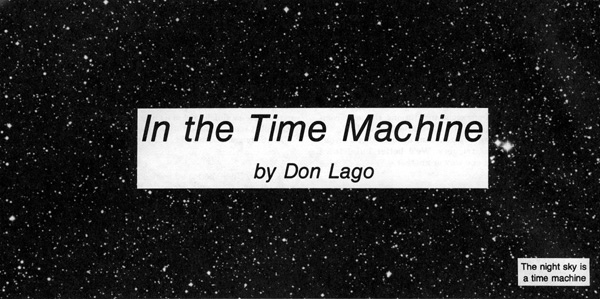
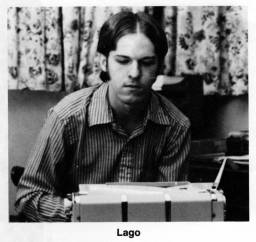 The night sky is a time machine
The night sky is a time machine
One of the favorite themes of science fiction writers is that of the time machine. In the years since H. G. Wells launched the idea we have been offered hundreds of variations of the voyage through time. Sometimes a misunderstood genius discovers the secret on his own, and sometimes humanity inherits the secret from a more advanced civilization. Almost invariably the stories involve a strange-looking machine and a certain amount of scientific-sounding mumbo jumbo to explain how it works. The time machine makes possible all sorts of adventures and social commentary, as well as brain-teasing paradoxes.
"Astronomers are cosmic archaeologists, digging through the ruins of a previous universe."
Beyond these specific story possibilities seems to lie a more basic fascination with the idea of dissolving the linear, moment-by-moment flow of time in which we live. These tales allow us, if only in imagination, to erase the boundaries that hold us fast in the present moment, boundaries that make us exiles from all of our past, and wander so freely through the past and future that we almost feel they belong to us.
Yet one doesn't need to turn to science fiction to find a time machine. You only need to step outside and gaze into the starry night. We live inside a time machine that is the universe itself.
The universe is a very simple time machine. It doesn't involve any strange and complicated machinery, only immense distances. We don't have to leave the present to travel into the past, for the past travels to us.
When we gaze into the depths of space, we are looking into the equally endless depths of time. When we see stars scattered across the sky we are also seeing stars scattered through time. We see the stars only as they were long ago, for space is so immense that starlight, even traveling at 300,000 kilometers per second, takes years to reach Earth. The farther away the star, the farther away in time we see it. We see the closest star, Alpha Centauri, as it was four years ago. We see the Andromeda galaxy as it was two and a half million years ago. And when, through telescopes, we spot the most distant objects in the universe, we are looking billions of years into the past. Even our own sun is seen through the warps and wrinkles of the time machine: we see it as it was eight minutes ago. The past has not been lost; the time machine contains it all. In the night sky one can see thousands of different moments of the past all at once, and through the telescope one can see billions. Here the whole of the past, from minutes ago to billions of years ago, exists simultaneously. Our days reside in the midst of a billion yesterdays.
Strangely, though man can see the past of the universe, he cannot see its present. We have no way of knowing what the universe beyond Earth is doing at this very moment. The present moment is trapped in the time machine and can only slowly drift towards Earth. We will have to wait four years to find out what Alpha Centauri is doing right now, and we will not live anywhere near long enough to find out what Andromeda is doing. For all we know all the other galaxies in the universe might have blinked out of existence two million years ago. All the other stars in our galaxy might have ceased burning three years ago. Our own sun might have blown itself apart seven minutes ago. Yet if you looked at the sun it would still seem perfectly-normal—at least for a few more moments.
Astronomers know nothing about the universe that surrounds us right now; they can study and talk about the universe only as it was long ago. The problem with living in a time machine is that our image of the universe is badly outdated. Of some galaxies we have only baby pictures, though they are now fully grown adults. We can look at a star and never guess that we are seeing only a ghost. If you could follow that ribbon of starlight back to its source you would find only the corpse of a star that had been dead for a thousand years or more. Yet that star still lingers in the time machine, shining brightly, haunting space and the mind of man.
Astronomers are often careless in speaking about the universe. They will say: "We have discovered a quasar ten billion light-years away," when they should say: "We have discovered a quasar that existed ten billion years ago." There's no telling whether that quasar still exists, or what it has become in the meantime. Astronomers are cosmic archaeologists, digging through the electromagnetic ruins of a previous universe, one that went on to become the totally unknown universe we live in today.
The universe as it is today will only slowly be revealed to Earth, and of course, by the time it has been totally revealed it will have become a very ancient universe. The reports will trickle in from the stars, beginning with Alpha Centauri four years from now.
"We don't have to leave the present to travel into the past, for the past travels to us."
Any race that tries to communicate across space is also trying to communicate across time. Its message will probably not be heard by its contemporaries, but only by individuals yet unborn. It is sending a message to the future.
Light seems to only crawl between the stars. Years and decades intervene between two races trying to share their lives with one another.
In this time machine the living can only eavesdrop on the past and call out to a future they will never see. Civilizations cannot share this moment of life together. They can only look into each other's yesterdays, meeting each other's ancestors. They can only send a bit of themselves to each other's tomorrow—to each other's descendants. Those who send a message know they are trying to communicate with minds that do not yet exist.
If we began broadcasting in a massive way tomorrow, our messages may first be heard by individuals who now are only genes stored in other bodies. We will be gone by then. We will be dust. They will be meeting a ghost. Our messages will wander on through space, and one by one, century by century, races will learn that somewhere, far away and long ago, on a planet that called itself Earth, there lived a generation of humans who called out to the stars. Two and a half million years from now, races in Andromeda will look deeply into the cosmic time machine—and they will see us. We will seem very remote to them, here in this ancient moment of time. Yet in another sense, a profounder sense, a truer sense, they will welcome us as their contemporaries. We will have shared together this strange, fleeting moment of light and consciousness deep in the center of a midnight with no beginning and no end.

A biographical sketch for Don Lago appeared in the Spring 1979 issue of COSMIC SEARCH (vol. 1, no. 2) in connection with his article "Circles of Stone and Circles of Steel". Another article by Lago appeared in the Fall 1979 issue (vol. 1, no. 4) entitled "A Hymn to Life in the Universe".
[Although the biographical sketch was not reproduced with this article in the magazine, I have reproduced it below from a previous article. — Webpage Editor]
 Don Lago, 22, resides in Missouri. He has attended college briefly. Beyond that, in his own words, "My occupation is finding out what people who have lived before me have discovered and thought about the world, and occasionally I have an interesting thought of my own. This is a full-time job in itself and doesn't leave much time to waste on such things as making money, which I am doing at a bookstore.
Don Lago, 22, resides in Missouri. He has attended college briefly. Beyond that, in his own words, "My occupation is finding out what people who have lived before me have discovered and thought about the world, and occasionally I have an interesting thought of my own. This is a full-time job in itself and doesn't leave much time to waste on such things as making money, which I am doing at a bookstore.
"I was born on the planet Earth (let's not be provincial), and plan to spend most of my life there. I find it very exciting to be alive when man is first searching for other minds in the universe, and hope to live long enough to learn what they have thought about the cosmos."
|
|
ABCs of Space
By: John Kraus
A. How Do You Harness a Black Hole?
Nowadays universities have astronomy departments, aeronautical engineering departments and even astronautical engineering departments. As yet, however, I am not aware of any astro-engineering departments. But some day there may be and what kind of courses might be offered? Probably ones on the mining of asteroids, construction of space habitats and even possibly one on "Harnessing of Black Holes."
A first consideration regarding the last item would be data on critical distances and strategies on how to approach a black hole without falling in. A second consideration would be a discussion of how a black hole is a potential source of great amounts of energy if you go at it right. And finally, the instructor would probably get down to the details of the astroengineering required with blueprints of a design and calculations of the expected power generating capability.
This may sound a bit futuristic and it is, but the famous text "Gravitation" by Charles Misner, Kip Thorne and John Wheeler includes a hypothetical example about how an advanced civilization could construct a rigid platform around a black hole and build a city on the platform.
 The discussion goes on to say that every day garbage trucks carry a million tons of garbage collected from all over the city to a dump point where the garbage goes into special containers which are then dropped one after the other down toward the black hole at the center of the city. The container is dragged by the black hole's strong gravity into a vortice-like whirlpool swirling around the black hole, spiralling inward toward the critical distance. When the container reaches a certain "ejection point" it dumps its load and as the garbage goes on into the hole the empty container recoils and is catapulted back up where it is caught by a giant bucket-studded flywheel. The container's energy spins the flywheel and this in turn runs a generator. With a succession of garbage containers falling in and flying back up, the generator provides a steady power supply for the city.
The discussion goes on to say that every day garbage trucks carry a million tons of garbage collected from all over the city to a dump point where the garbage goes into special containers which are then dropped one after the other down toward the black hole at the center of the city. The container is dragged by the black hole's strong gravity into a vortice-like whirlpool swirling around the black hole, spiralling inward toward the critical distance. When the container reaches a certain "ejection point" it dumps its load and as the garbage goes on into the hole the empty container recoils and is catapulted back up where it is caught by a giant bucket-studded flywheel. The container's energy spins the flywheel and this in turn runs a generator. With a succession of garbage containers falling in and flying back up, the generator provides a steady power supply for the city.
To quote from Misner, Thorne and Wheeler,
"Not only can the inhabitants of the city use the black hole to convert the entire rest mass of their garbage into the kinetic energy of the vehicle (or container) and hence into electrical power but they can also convert some of the mass of the black hole into electrical power!"
Now a million tons (mass) of garbage a day converted into energy in this way would produce more than a billion trillion watts of power or nearly a billion times the present-day power production of the entire world.
Whereas Rube Goldberg's schemes were usually plausible but impossible, this black hole scheme seems both plausible and possible (theoretically). Many details would need to be worked out, but who knows, it may already be used by an advanced civilization somewhere in the universe.
Summary:
- A black hole can provide the ultimate in trash disposal and also huge amounts of energy.
- Although we do not yet offer courses on the details, a black hole city with power generating system may already be in existence somewhere in the universe.
B. Is the Universe 10 or 20 Billion Years Old?
Using radio and infra-red techniques, a team of astronomers has been in the news lately with results implying a universe 10 billion years old. This is half the value currently used by many other astronomers. While the news announcement has caused quite a stir in astronomical circles its effect on Wall Street was imperceptible.
The team in the news consists of Marc Aaronson (Steward Observatory, University of Arizona), Jeremy Mould (Kitt Peak National Observatory, Tuscon, Arizona), John Huchra (Harvard/Smithsonian Center for Astrophysics), and Woodruff Sullivan III, Robert Schommer and Gregory Bothun (University of Washington).
How old is the universe? It is so old and big that this is very difficult to determine. Assuming the universe has expanded uniformly since the Big Bang, its age increases with its size. If we know how big it is, then we know how old it is. The ratio of the radius of the universe to the velocity of light is a number whose reciprocal is called the "Hubble constant", after Dr. Edwin P. Hubble (1889-1953), the father of the expanding universe idea. Put another way, the reciprocal of the Hubble constant equals the age of the universe. Thus, the smaller the Hubble constant, the older the universe.
In my text-book "Radio Astronomy" (McGraw-Hill) published in 1966, I state:
"The correct value for the Hubble constant is uncertain. A nominal value in wide present-day (circa 1965) usage is 100 kilometers per second per megaparsec. Values between 180 and 75 have been used during the past decade (corresponding to ages of about 5 to 13 billion years)."
Using the 100 kilometer value yields an age for the universe of about 10 billion years.
In the years after my book was published, astronomers reported lower and lower values of the Hubble constant until recently it was thought to be only half as large implying a universe 20 billion years old. Now come Aaronson and his team with a Hubble constant of almost 100 putting us back again to 10 billion years.
In the premier issue of COSMIC SEARCH (January 1979) we adopted 15 billion years as a nominal value for the age of the universe (and 15 billion light-years for its radius) in the COSMIC CALENDAR and DISTANCE TABLE. It is interesting that this value is the average of the extremes of 10 and 20 billion years currently under discussion. [Note. Although not printed in this issue of the magazine, the COSMIC CALENDAR and the DISTANCE TABLE are reproduced at the end of this webpage.]
The apparent uncertainty in the Hubble constant is not surprising since the great distances involved cannot be measured directly but must be estimated by indirect, roundabout methods which may be ambiguous. Astronomers are simply groping and working their way toward a more certain value.
The pioneering step that made the new radio and infra-red measurements possible was taken in 1975 at the National Radio Astronomy Observatory (NRAO), Green Bank, West Virginia, by Brent Tully (University of Hawaii) and Richard Fisher (NRAO). They noted a correlation between the brightness of a spiral galaxy and the broadening of its 21 centimeter hydrogen line radiation. The more massive a galaxy, the faster it rotates and the broader the line due to the Doppler shift of radiation from
parts approaching (wavelength shorter) and from the parts receding (wavelength longer). Thus, from the broadness of the line the mass of the galaxy could be estimated. The more massive the galaxy the more light it should emit. So, if a galaxy which appears faint is deduced from its hydrogen line width to be massive, it must be far away. Refining this method, Aaronson, Mould and Huchra, used infra-red radiation instead of light to gauge the brightness, and measured the distance of much more remote galaxies than previously possible. Astronomers quoting a smaller Hubble constant have used optical methods on much nearer galaxies. Aaronson and his team do not believe that what is going on nearby is necessarily representative of the large scale cosmic motions farther out.
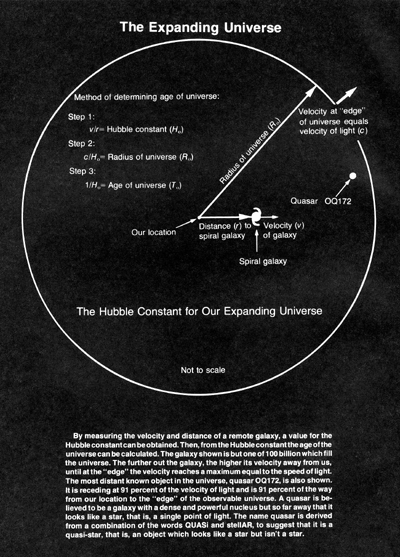 The velocity of recession of a distant galaxy (as determined from its redshift) divided by its distance gives a value for the Hubble constant. If further and further galaxies could be measured the velocity would approach the velocity of light and the distance the radius of the observable universe but, for uniform expansion, the ratio, or Hubble constant, should remain the same, that is, be what its name implies: a constant.
The velocity of recession of a distant galaxy (as determined from its redshift) divided by its distance gives a value for the Hubble constant. If further and further galaxies could be measured the velocity would approach the velocity of light and the distance the radius of the observable universe but, for uniform expansion, the ratio, or Hubble constant, should remain the same, that is, be what its name implies: a constant.
Will astronomers agree on 10 billion years or will it be 20? The controversy may go on for years. In the meantime we will continue to use 15 (plus or minus 5) in the COSMIC CALENDAR.
The significance of the age of the universe is that if the universe is young we may be the only example of intelligent life but if it is old there may have been time for life to evolve in many places and we may be "e pluribus unum" or "one of many" examples.
AGE OF THE UNIVERSE TABLE
(Small Hubble, old universe; big Hubble, young universe)
Hubble
constant
(in hubbles*) |
Radius of
universe
(in billions of
light-years) |
Age of
universe
(in billions
of years) |
|---|
50
67
100 |
20
15
10 |
20
15
10 |
|
*"One hubble equals one kilometer per second per megaparsec where one megaparsec equals 3.26 million light-years. The table values for the radius and age of the universe are nominal round-offs.
The radius R0 of the universe equals the velocity of light c divided by the Hubble constant H0, (R0 = c/H0). The age of the universe in years is numerically equal to the radius of the universe in light-years. A convenient relation is that the age of the universe T0 in billions of years is approximately equal to 1000 divided by the Hubble constant in hubbles (or T0 = 1000)/H0). (If we use a more accurate value of 978 instead of 1000 and Aaronson's stated value of 95 hubbles, we get an age of 10.3 (= 978/95) billion years).
A Hubble constant of 100 hubbles implies that a 10 meter radial length stretches 1 millimeter longer in one million years. Thus, we may express 100 hubbles as 1 millimeter per million years per 10 meters.
HUBBLE TROUBLE
Hubble bubble toil and trouble,
The cosmos ages 'til it's double.
Most distant quasar one-seven-two*,
How old, how far away are you?
Ten billions of years or twenty?
Let's say fifteen is aplenty,
And spare our good Dr. Hubble
From further change and trouble.
*Refers to the quasar radio source OQ172 with the greatest known redshift (3.54) and inferred distance close to the observable limit (or "edge") of the universe.
C. Waves of All Kinds
There are water waves, sound waves, heat waves and many more kinds of waves. Although they may differ in certain respects, they all have one thing in common: They move or travel with a characteristic velocity. Sound waves travel in air 1000 feet per second while radio waves can travel around the earth seven times in a second.
We can divide waves in general into two groups: (1) those that travel only through solids, liquids and gases, and (2) those that can travel through vacuum (or empty space).
The first group we might describe as mechanical waves, including:
Water waves, visible on the surface of lakes or oceans,
Seismic waves, or vibrations transmitted through the ground from earthquakes,
Sound waves, by which we hear,
Waves on strings or wires, as in musical instruments.
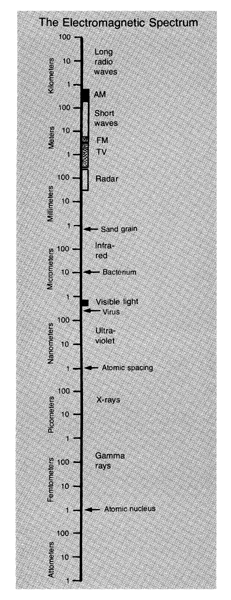 The second group embraces the electromagnetic waves, including:
The second group embraces the electromagnetic waves, including:
Radio waves, which carry AM, FM, TV, radar and all kinds of communications,
Infra-red waves, or heat waves, which warm our bodies,
Light waves, by which we see,
Ultra-violet waves, which can sterilize and tan,
X-rays or waves, which doctors and dentists use to see through your body,
Gamma-rays or waves, which are emitted by some uranium products and in vast amounts by nuclear explosions.
All of these waves are fundamentally similar, involving the propagation of electric and magnetic effects at a speed, in air or vacuum, of 300,000 kilometers per second. They differ only in wavelength from the radio waves at the long wavelength end to gamma waves at the short wavelength end. The range in wavelength is enormous. Radio waves may be many kilometers in length while gamma rays, on the other hand, are so short that it takes a billion of them to stretch across the dot or period at the end of this sentence. The relationship of these waves is presented by The Electromagnetic Spectrum, with scales of wavelength in meters.
Caption for the graphic "The Electromagnetic Spectrum":
The electromagnetic spectrum or wavelength scale from the shortest gamma rays to the longest
radio waves. The wavelengths for AM, FM and TV broadcasting, for radar and for visible light are indicated. The size of objects including a sandgrain, a bacterium, a virus, the spacing of atoms and an atomic nucleus are shown for comparison.
Thus far we have neglected mention of another kind of wave which is believed to travel through empty space at the same speed as electromagnetic waves, yet it isn't an electromagnetic wave. This is the gravity wave discussed in ABCs of Space in the last issue of COSMIC SEARCH.
These waves are presumably radiated by rotating double star systems and during catastrophic events such as a stellar collapse into a pulsar or black hole. If the rotating star system made one revolution per week the wavelength would be gigantic: one-half light-week. The distance to the moon is only one light-second and the distance to Pluto only a few light-hours so the gravity wavelength from the stars would be seven times the diameter of our solar system (at the orbit of Pluto). Some day we may be able to detect such waves.
Summary:
- A sound wave can travel through air but not through vacuum.
- Radio waves and light waves can travel through vacuum.
- Radio waves and light waves are electromagnetic waves.
- Gravity waves are believed to travel as fast as electromagnetic waves but are not electromagnetic.
COSMIC CALENDAR
| 15 billion BC | Universe began (BIG BANG) |
| 10 billion BC | Our galaxy formed |
| 5 billion BC | Solar system (sun, earth and other planets) formed |
| 2 million BC | Homo sapiens emerged |
| 5000 BC | Writing invented |
| 1888 AD | Hertz produced radio waves |
| 1903 AD | Letter "S" sent by radio waves across Atlantic Ocean by Marconi |
| 1959 AD | Cocconi and Morrison proposed SETI |
| 1960 AD | First attempt to detect extraterrestrial civilizations by Drake |
| 1979 AD | First issue of COSMIC SEARCH |
DISTANCE TABLE
Distances in light travel time (approx.)
| Earth to moon | 1 second |
| Earth to sun | 500 seconds (8 min.) |
| Sun to Mars | 12.5 minutes |
| Sun to Jupiter | 40 minutes |
| Sun to Pluto | 5.5 hours |
| Solar system diameter (at orbit of Pluto) | 11 hours |
| Sun to nearest star | 4 years |
| Sun to center of galaxy | 30,000 years |
| Diameter of galaxy | 100,000 years |
| Distance of Andromeda galaxy | 2 million years |
| Distance to "edge" of universe | 15 billion years |
To convert light travel time to kilometers multiply travel time in seconds by velocity of light (300,000 kilometers per second).
|
College Courses on "Life in the Universe"
By: Editors
College courses on "Life in the Universe" are becoming increasingly popular. Although dealing mainly with astronomy, many of the courses include much interdisciplinary material from such diverse areas as biology, medicine, psychology, physiology,
semantics and communication. A total of 24 colleges offering or planning to offer courses are reported in this and previous issues of COSMIC SEARCH (see accompanying list).
COSMIC SEARCH
List of College Courses on
Life in the Universe
|
|
The number in parentheses with each listing refers to the serial number of COSMIC SEARCH in which the course is described — (3): Summer 1979: (4): Fall 1979; (5): Winter 1980, (6): Spring 1980.
Appalachian State University,
Boone, North Carolina (5)
Bowling Green State University,
Bowling Green, Ohio (5)
California State University,
Fullerton, California (5)
Case Western Reserve University,
Cleveland, Ohio (4)
Consumes River College,
Sacramento. California (3)
John Carroll University,
University Heights, Ohio (4)
Kansas State University,
Manhattan. Kansas (5)
Leeward Community College,
Kaneohe, Hawaii (4)
Louisiana State Universtity,
Baton Rouge. Louisiana (4)
Menlo College,
Menlo Park, California (3)
State University of New York,
Stony Brook. New York (6)
Ohio State University,
Columbus, Ohio (3)
Otterbein College,
Westerville, Ohio (4)
St. Olaf College,
Northfield, Minnesota (5)
San Diego State University,
San Diego, California (3)
University of San Francisco,
San Francisco. California (4)
Sheridan College,
Sheridan. Wyoming (5)
Stanford University,
Stanford, California (4)
Stockton State College,
Pomona, New Jersey (3)
University of Texas,
Austin, Texas (6)
University of Vienna,
Vienna, Austria (6)
Washington and Jefferson College,
Washington, Pennsylvania (4)
Western Michigan University,
Kalamazoo. Michigan (5)
Wheaton College,
Norton, Massachusetts (4)
|
We would like to include additional institutions. Please send information to Prof. John Kraus, Ohio State University Radio Observatory, 2015 Neil Ave., Columbus, Ohio 43210. Years given, attendance, a syllabus (if available) and other information will be appreciated.
Newest listings are:
Institution: State University of New York, Stony Brook, Long Island, New York 11794.
Instructor: Tobias Owen
Title: Intelligent Life in the Universe
Content: The astronomical setting, the origin and evolution of life on the earth, the search for life in our solar system and the search for life in the universe, including an examination of the UFO and "Ancient Astronaut" controversies.
Reference: Shklovskii and Sagan, "Intelligent Life in the Universe". With Donald Goldsmith of Interstellar Media, Berkeley, California, Owen has written a new book, "The Search for Life in the Universe" published by Benjamin/Cummings, to be used in future offerings.
Years given: Since 1971.
Enrollment: 100 to 200 undergraduate students of widely varying backgrounds.
Institution: University of Vienna, A-1180 Vienna, Austria
Instructor:Dr. Maria G. Firneis, Institute of Astronomy
Title: Planetary Systems
Content: The formation of our planetary system, detection of planetary systems, organic compounds in interstellar matter, high-frequency radio engineering, Project OZMA, CETI, SETI and CYCLOPS, self-organization in biochemistry, hypercycles, evolution of the genetic code, DNA replication, space colonization.
References: Bracewell, "The Galactic Club"; Sagan, "The Cosmic Connection"; Shklovskii and Sagan, "Intelligent Life in the Universe"; Dole, "Habitable Planets for Man"; Dermott, "The Origin of the Solar System"; Fuchs, "Leben unter ferner Sonnen"; Hermann, "Astrobiologie"; Heppenheimer, "Colonies in Space"; NASA-Ames, "Project CYCLOPS"; Articles from Icarus, Vistas in Astronomy, Annual Review of Astronomy and Astrophysics, COSMIC SEARCH and Mercury.
Years given: 1977, 1979
Enrollment: 36 (1977), 45 (1979).
Institution: University of Texas, Austin, Texas 78712
Instructors: Neal J. Evans II, Thomas Barnes, John Scalo and Fritz Benedict.
Title: Extraterrestrial Life (Astronomy 309L)
Content: The nature of the subject, cosmic evolution, terrestrial evolution, cultural evolution, life in the solar system, life outside the solar system, communication with extraterrestrial intelligence, interstellar travel.
References: Ponnamperuma and Cameron, "Interstellar Communication: Scientific perspectives"; Scientific American Sept. 1978 issue on "Evolution"; Ridpath, "Worlds Beyond"; Ponnamperuma, "The Origins of Life"; Shklovskii and Sagan, "Intelligent Life in the Universe"; Dole and Asimov, "Planets for Man".
Years given: Since 1975.
Enrollment: 100 to 150.
Note: We would be interested to know if there are any "Life in the Universe" courses which can be taken by correspondence. We have had inquiries. Please write to COSMIC SEARCH.
|
Allocating the Radio Spectrum
By: Vernon Pankonin
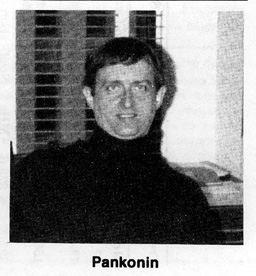
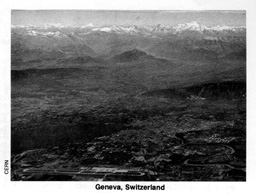 The World Administrative Radio Conference (WARC), which was held in Geneva, Switzerland, during October and November 1979, performed a complete review of the International Radio Regulations which include a Table of Frequency Allocations. In the allocations table, the radio spectrum from 9 kHz to 275 GHz is partitioned into frequency bands for use by thirty-one radio communication services of which radio astronomy is one.
The World Administrative Radio Conference (WARC), which was held in Geneva, Switzerland, during October and November 1979, performed a complete review of the International Radio Regulations which include a Table of Frequency Allocations. In the allocations table, the radio spectrum from 9 kHz to 275 GHz is partitioned into frequency bands for use by thirty-one radio communication services of which radio astronomy is one.
The Radio Regulations are administered by the International Telecommunications Union (ITU), which is a specialized agency of the United Nations. Approximately 144 of the 154 member countries of the ITU sent a total of about 2200 delegates to the
WARC. The U.S. delegation numbered 65.
Radio astronomy was accepted as a radio service at the last general WARC in 1959, and it was awarded protection in a few frequency bands. However, it was a young science then, and its needs have greatly expanded and changed as it has matured. Now any band in the radio spectrum can be covered at one or more of the major radio observatories around the world. At the same time that the requirements of radio astronomy have become broader and more stringent, the competition for the limited spectrum has become increasingly severe.
Radio astronomy and some space services are unique in the radio communications field in that they are entirely passive, that is, they only receive and do not transmit. Also a typical observation requires a sensitivity to extremely low levels of radiation which makes radio astronomy particularly susceptible to man-made transmissions. The technical arm of the ITU, the
International Radio Consultative Committee (CCIR), has defined realistic levels of harmful interference to radio astronomy observations in a report, which severely restricts the possibilities of the active and radio astronomy services sharing a frequency band.
The convening of WARC-79 was announced several years ago, and radio astronomers have expended considerable effort to formulate an international position in order to present a united front. They have adopted the posture that protection should be sought:
(1) for continuum bands at octave intervals throughout the spectrum above 10 MHz with at least a 1 percent bandwidth in each band, and
(2) for approximately 20 lines emitted from molecules and atoms which are considered of prime astrophysical importance.
For the latter, the bandwidth should be ±0.1 percent (±300 kilometers per second Doppler shift) centered on the rest frequency of the line to accommodate, to a certain extent, the motions of the sources relative to the Earth. Continuum observations require relatively wide bandwidths for increased sensitivity, but the center frequencies of the bands are fairly flexible. On the other hand, the frequencies for spectral line observations are fixed by nature, and relatively narrow bandwidths are
sufficient.
Although the radio astronomers could agree fairly easily amongst themselves on the requirements of the science, proposals to the Conference could only be submitted by national members. National positions for the WARC were developed over several years, and the status of radio astronomy in a given nation's proposals largely depended on the success of radio astronomers in their domestic preparations. Hence, the radio astronomy positions of the countries varied widely. The last possibility for
negotiation was during the deliberations of the Conference itself, and there were radio astronomers on the delegations of Argentina (Bajaja), Australia (Whiteoak), Canada (Doherty), the Federal Republic of Germany (Grahl), India (Swarup), the Netherlands (Kahlmann and Schilizzi), Nigeria (Okoye), the Soviet Union (Dubinsky), the United Kingdom (Homer), and the United States (Pankonin).
The International Radio Regulations provide several levels for protecting radio services from mutual interference. The highest level of protection is a primary, exclusive allocation in a frequency band; that is, only one service is authorized to operate in a given band. The second level is also a primary status but the same band is shared on an equal basis with one or more additional services. The third level is called secondary, where a service is authorized to operate but may not interfere with other services in that band which have primary status. The fourth level offers no formal protection but is a notification that a service is using the band. This last type is often used for spectral line observations, and it simply calls attention to the use of the band by radio astronomy and asks for protection when practicable.
The protection for radio astronomy in the International Radio Regulations before and after WARC-79 is summarized in Tables 1 and 2. Radio astronomers certainly did not achieve all of their goals, but in general their position was improved at the WARC. Although considerable gains in formal protection were made at frequencies above 40 GHz, the most significant general improvement was in the standardization and strengthening of the radio astronomy footnotes. Radio astronomers have made liberal use of footnotes in many frequency bands, and the application of these has now been made consistent and uniform. Footnotes now appear in practically every band where radio astronomy has an allocation or notification of use, and the texts have been standardized. The new footnotes are of two types (applied as indicated in Table 2) which, with certain minor variations, all contain the wording given at the bottom of Table 2.
Other notable actions at the WARC include an article which was added to the Radio Regulations to emphasize some of the special problems faced by radio astronomers, and to give examples of the practicable steps for protection which are alluded to in the footnotes.
Radio astronomers have long realized that the far side of the Moon could provide a protected zone which is naturally shielded from transmissions on or near the Earth, and that at some point in the future it may be necessary and feasible to operate from such a distant base. An article was added to the Radio Regulations giving protection to radio astronomy and other passive services in the lunar shielded zone over most of the radio spectrum. Also a footnote was inserted in appropriate bands calling attention to the search for signals transmitted by extra-terrestrial intelligence (SETI) which reads as follows:
In the bands 1400 to 1427 MHz, 101 to 120 GHz, and 197 to 220 GHz, passive research is being conducted by some countries in a programme for the search for intentional emissions of extra-terrestrial origin.
The radio regulations which were formulated at the WARC-79 have the force of an international treaty for a country once the Final Acts are signed (and in the United States ratified by the Senate). According to the schedule, the new radio regulations will take effect January 1, 1982, and they are expected to remain in force without major revision until the end of this century. These regulations, however, only provide for the allocation of frequency bands to radio services on the international level. Additional protection for radio astronomy is necessary and can be achieved by enlightened assignment of frequencies within a band to stations of an authorized service, by effective compliance checking, and by adequate technical standards for
equipment. All of these areas are tasks of the individual national administrations. Thus, the radio astronomers' efforts do not end with WARC-79. Representation must also be maintained in the daily regulatory process in each country.

 Vernon Pankonin was born in Ogallala, Nebraska, in 1946. He received the B.S. degree in physics and mathematics from the University of Nebraska (Lincoln) in 1968 and the Ph.D. degree in astronomy from Cornell University in 1973. He was guest scientist and later assistant staff scientist at the Max-Planck-Institute for Radioastronomy, Bonn, West Germany from 1973 to
1979. Since September 1979 he has been Radio Spectrum Manager at the U.S. National Science Foundation, Washington, D.C. Dr. Pankonin was an official U.S. delegate to the WARC-79 conference in Geneva, Switzerland.
Vernon Pankonin was born in Ogallala, Nebraska, in 1946. He received the B.S. degree in physics and mathematics from the University of Nebraska (Lincoln) in 1968 and the Ph.D. degree in astronomy from Cornell University in 1973. He was guest scientist and later assistant staff scientist at the Max-Planck-Institute for Radioastronomy, Bonn, West Germany from 1973 to
1979. Since September 1979 he has been Radio Spectrum Manager at the U.S. National Science Foundation, Washington, D.C. Dr. Pankonin was an official U.S. delegate to the WARC-79 conference in Geneva, Switzerland.
|
Radio Services and Nomenclature
Some of the services with which radio astronomy shares the frequency spectrum are broadcasting (AM. FM and TV), aeronautical radio communication, aeronautical radio navigation, maritime radio communication, maritime radio navigation, radio location (radar), land mobile communication, fixed point-to-point communication, amateur, earth-space communication, communication between space stations and standard frequency and time transmissions.
In the U.S., radio regulations are administered by the Federal Communications Commission (FCC), Washington. D.C. 20554. Copies of the current Rules and Regulations of the FCC are available from the Superintendent of Documents, Government Printing Office, Washington, D.C. 20402.
In the accompanying article with tables on radio astronomy frequency allocations, the term continuum refers to the fact that many cosmic radio sources emit continuously over a wide band of frequencies or wavelengths. Radio astronomy observations of this continuum radiation can be accomplished with a number of protected channels located at intervals throughout this band.
Although the exact frequency or wavelength of these channels is not critical for continuum observations this is not the case for observations of another type of cosmic radio radiation from molecules or atoms, each of which has a characteristic frequency or wavelength called a line. Examples are the atomic hydrogen line at 1400 to 1427 megahertz (21 centimeters), deuterium (heavy hydrogen) at 322 to 328.6 megahertz (92 centimeters), the hydroxyl radical (OH) at 1610.6 to 1722.2 megahertz (18 centimeters), etc,
-Eds.
|
[Note. Tables 1 & 2 below have been reformatted in this webpage from the versions in the magazine as follows: (1) the tables are organized like spreadsheets with grid lines (borders) showing; and (2) the Frequency Band has been divided into three columns with the labels: Low (meaning frequency at the low end of the band), High (meaning frequency at the high end of the band), and Units (meaning the frequency units used).]—Webpage Editor
TABLE 1
RADIO ASTRONOMY ALLOCATIONS
(prior to WARC-79)
|
| Frequency Band | | |
| Low | High | Units | Protection Status | Principal Use |
| 21850 | 21870 | kHz | PRIMARY exclusive | Continuum |
| 37.75 | 38.28 | MHz | Secondary | Continuum |
| 73 | 74.6 | MHz | PRIMARY exclusive (only in Regions 2 & 3)* | Continuum |
| 150.05 | 153 | MHz | PRIMARY shared with active (only in Region 1) | Continuum |
| 322 | 328.6 | MHz | Notification of Use | Continuum |
| 406.1 | 410 | MHz | PRIMARY shared with active | Continuum |
| 608 | 610 | MHz | PRIMARY exclusive in Region 2. Notification of Use in Regions 1 & 3 | Continuum |
| 1350 | 1400 | MHz | Notification of Use | Redshifted hydrogen |
| 1400 | 1427 | MHz | PRIMARY exclusive | Hydrogen |
| 1611.5 | 1612.5 | MHz | Notification of Use | Hydroxyl |
| 1660 | 1670 | MHz | PRIMARY shared with active | Hydroxyl |
| 1720 | 1721 | MHz | Notification of Use | Hydroxyl |
| 2670 | 2690 | MHz | Notification of Use | Continuum |
| 2690 | 2700 | MHz | PRIMARY exclusive | Continuum |
| 4825 | 4835 | MHz | Notification of Use | H2CO |
| 4950 | 4990 | MHz | Notification of Use | Continuum |
| 4990 | 5000 | MHz | PRIMARY exclusive in Region 2. PRIMARY shared with active in Regions 1 & 3 | Continuum |
| 5750 | 5770 | MHz | Notification of Use | Continuum |
| 10.6 | 10.68 | GHz | PRIMARY shared with active | Continuum |
| 10.68 | 10.7 | GHz | PRIMARY exclusive | Continuum |
| 14.485 | 14.515 | GHz | Notification of Use | H2CO |
| 15.35 | 15.4 | GHz | PRIMARY exclusive | Continuum |
| 22.21 | 22.26 | GHz | PRIMARY shared with active | H2O |
| 23.6 | 24 | GHz | PRIMARY exclusive | Continuum & ammonia |
| 31.2 | 31.3 | GHz | Notification of Use | Continuum |
| 31.3 | 31.5 | GHz | PRIMARY exclusive | Continuum |
| 36.458 | 36.488 | GHz | Notification of Use | H+ |
52
58.2
64 | 54.25
59
65 | GHz | Passive bands but no notification of use for radio astronomy | Continuum |
| 86 | 92 | GHz | PRIMARY shared with passive | Numerous lines |
| 101 | 102 | GHz | Passive band but no notification of use for radio astronomy | Continuum |
| 115.16 | 115.38 | GHz | Notification of Use | CO |
| 130 | 140 | GHz | PRIMARY shared with passive | Continuum |
| 182 | 185 | GHz | Passive band but no notification of use for radio astronomy | H2O |
| 230 | 240 | GHz | PRIMARY shared with passive | CO |
* In the International Radio Regulations, the world is divided into three regions. Roughly Region 1 comprises Europe and Africa, Region 2 is the Western Hemisphere, and Region 3 is Asia and Australia.
TABLE 2
RADIO ASTRONOMY ALLOCATIONS
(WARC-79)
|
| Frequency Band | | |
| Low | High | Units | Protection Status (Footnote Type) | Principal Use |
| 13360 | 13410 | kHz | PRIMARY shared with active (2) | Continuum |
| 25550 | 25670 | kHz | PRIMARY exclusive (special) | Continuum |
| 37.5 | 38.25 | MHz | Secondary (2) | Continuum |
| 73 | 74.6 | MHz | PRIMARY exclusive in Region 2 (no footnote). Notification of Use in Regions 1 & 3 (2) | Continuum |
| 150.05 | 153 | MHz | PRIMARY shared with active only in Region 1, Australia, India (2) | Continuum |
| 322 | 328.6 | MHz | PRIMARY shared with active (2) | Continuum & deuterium |
| 406.1 | 410 | MHz | PRIMARY shared with active (2) | Continuum |
| 608 | 614 | MHz | PRIMARY (active secondary) in Region 2 (no footnote). Permitted in African Broadcast Area; secondary in Regions 1 & 3 (2) | Continuum |
| 1330 | 1400 | MHz | Notification of Use (2) | Hydrogen |
| 1400 | 1427 | MHz | PRIMARY - passive band (1) | Hydrogen |
| 1610.6 | 1613.8 | MHz | Secondary (2) | Hydroxyl |
| 1660 | 1660.5 | MHz | PRIMARY shared with active (2) | Hydroxyl |
| 1660.5 | 1668.4 | MHz | PRIMARY (active secondary) (2) | Hydroxyl |
| 1668.4 | 1670 | MHz | PRIMARY shared with active (2) | Hydroxyl |
| 1718.8 | 1722.2 | MHz | Secondary (2) | Hydroxyl |
| 2655 | 2690 | MHz | Secondary (2) | Continuum |
| 2690 | 2700 | MHz | PRIMARY - passive band (1) | Continuum |
3260
3332
3345.8 | 3267
3339
3352.5 | MHz | Notification of Use (2) | CH |
| 4800 | 4990 | MHz | Secondary (2) | Continuum & H2CO |
| 4990 | 5000 | MHz | PRIMARY shared with active (2) | Continuum |
| 10.6 | 10.68 | GHz | PRIMARY shared with active (2) | Continuum |
| 10.68 | 10.7 | GHz | PRIMARY - passive band (1) | Continuum |
| 14.47 | 14.5 | GHz | Secondary (2) | H2CO |
| 15.35 | 15.4 | GHz | PRIMARY - passive band (1) | Continuum |
| 22.01 | 22.21 | GHz | Notification of Use (2) | H2O |
| 22.21 | 22.5 | GHz | PRIMARY shared with active (2) | H2O |
22.81
23.07 | 22.86
23.12 | GHz | Notification of Use (2) | NH3 |
| 23.6 | 24 | GHz | PRIMARY - passive band (1) | Continuum & ammonia |
| 31.2 | 31.3 | GHz | Notification of Use (2) | Continuum |
| 31.3 | 31.5 | GHz | PRIMARY - passive band (1) | Continuum |
| 31.5 | 31.8 | GHz | PRIMARY - passive band in Region 2 (1). PRIMARY (active secondary) in Regions 1 & 3 (2) | Continuum |
| 36.43 | 36.5 | GHz | Notification of Use (2) | H+ |
| 42.5 | 43.5 | GHz | PRIMARY shared with active (2) | Continuum & Si0 |
| 48.94 | 49.04 | GHz | PRIMARY shared with active (2) | CS |
51.4
58.2
64 | 54.25
59
65 | GHz | Notification of Use - passive bands (1) | Continuum |
| 72.77 | 72.91 | GHz | Notification of Use (2) | H2CO |
| 86 | 92 | GHz | PRIMARY - passive band (1) | Numerous lines |
| 93.07 | 93.27 | GHz | Notification of Use (2) | HNN+ |
| 97.88 | 98.08 | GHz | PRIMARY shared with active (2) | CS |
| 105 | 116 | GHz | PRIMARY - passive band (1) | CO |
140.69
144.68
145.45
146.82 | 140.98
144.98
145.75
147.12 | GHz | PRIMARY shared with active (2) | H2CO
DCN
H2CO
CS |
| 150 | 151 | GHz | Secondary (2) | NO, H2CO |
| 164 | 168 | GHz | PRIMARY - passive band (no footnote) | Continuum |
174.42
177
178.2
181 | 175.02
177.4
178.6
181.6 | GHz | Secondary (2) | C2H
HCN
HCO+
HNC |
| 182 | 185 | GHz | PRIMARY - passive band (1) | H2O |
| 186.2 | 186.6 | GHz | Secondary (2) | HNN+ |
| 217 | 231 | GHz | PRIMARY - passive band (1) | CO |
| 250 | 251 | GHz | PRIMARY - passive band (2) | NO |
| 257.5 | 258 | GHz | Secondary (2) | NO |
| 262.24 | 262.76 | GHz | PRIMARY shared with active (2) | C2H |
| 265 | 275 | GHz | PRIMARY shared with active (2) | HCN, HCO+, HNC |
278
343 | 280
348 | GHz | Notification of Use (not allocated) | HNN+
CO |
Footnote Types:
1. All emissions in the band between frequencies listed are prohibited.
2. In making assignments to stations ..... administrations are urged to take all practicable steps to protect the radio astronomy service from harmful interference. Emissions from space or airborne stations can be particularly serious sources of interference to the radio astronomy service.
|
The SEnTlnel
By: Robert S. Dixon
The Flag of Earth
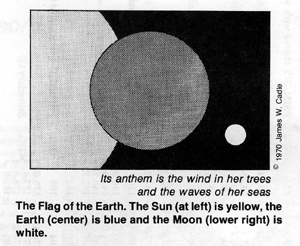 Before Man landed on the moon, there was a small group of people in the United States promoting the idea that the first flag planted by Man on an extraterrestrial body should be a flag representing the people of Earth, rather than just one nation. The underlying philosophy was that sooner or later Man would achieve the moon, and it was simply a matter of historical and political circumstances that enabled the United States to be the instrument by which it was first accomplished. Clearly, all inhabitants of Earth realized that it was the United States which led the way, so no loss of national recognition would have occurred as a result of not planting the American flag. The thought was that the reverse would be true: a showing of humility and sharing the accomplishment with all mankind would gain more respect than chestpounding. As history shows, however, the movement failed.
Before Man landed on the moon, there was a small group of people in the United States promoting the idea that the first flag planted by Man on an extraterrestrial body should be a flag representing the people of Earth, rather than just one nation. The underlying philosophy was that sooner or later Man would achieve the moon, and it was simply a matter of historical and political circumstances that enabled the United States to be the instrument by which it was first accomplished. Clearly, all inhabitants of Earth realized that it was the United States which led the way, so no loss of national recognition would have occurred as a result of not planting the American flag. The thought was that the reverse would be true: a showing of humility and sharing the accomplishment with all mankind would gain more respect than chestpounding. As history shows, however, the movement failed.
At that time the flag of the United Nations was the one being promoted. But in a sense, the flag of the United Nations is not really a flag of Earth. It is the flag of a specific international
organization. It is probably not appropriate to fly the UN flag in association with any activity not specifically authorized and sponsored by the UN. The UN flag is intended to be meaningful among men and nations on Earth, rather than among Earth and other civilizations.
Now a true flag of Earth has been created, and is being distributed and promoted on a non-political, non-profit basis. In 1970, James W. Cadle from a rural area near St. Joseph, Illinois, authored this flag that depicts very simply the yellow Sun, the blue Earth and the white Moon.
The flag illustrates the fact that Earth has only a single moon, and it is not negligible in size relative to its planet. This characteristic of the Earth-Moon system is unique in the solar system and may be very unusual in any stellar system. It has been speculated that such an association is necessary for the evolution of intelligent life, since the moon causes the tides that may have allowed sea creatures to gradually adapt to existence on land. This fact, together with the actual colors of the Sun, Earth and Moon, make a flag that is meaningful not only to Man, but perhaps to other civilizations as well.
Cadle was recently the subject of a National Public Radio program, and described how he distributes and promotes the flag using only his own resources. In his own words,
"The Flag of Earth is ultimately a simple graphic symbol that stands for this planet and its immediate environs. As humanity matures and inevitably leaves its home, the need will be of a standard neither of a planet subdivision, nor, in a certain sense, of that planet as a whole. This yellow star will be the mark of home to a traveler long after the planet Earth is lost to the background. So also is this star primarily responsible for the very existence of humanity."
These ideas and sentiments are also true of searching for extraterrestrial intelligence (SETI). Accordingly, a Flag of Earth is displayed at the Ohio State-Ohio Wesleyan Radio Observatory, as a symbol of the fact that the ongoing search for other civilizations is in the largest sense being done by Man, with the individuals and organizations involved being only the instruments by which Man is carrying out this search.
Should the Flag of Earth be adopted as the unofficial flag of those that search for extraterrestrial intelligence? It would have to be on an "unofficial" basis because there is no ruling council to make it "official" (perhaps this is just as well). Write to COSMIC SEARCH and tell us your opinions.
Jovian Moon Appropriate Life Site?
The Voyager 2 spacecraft revealed that one of Jupiter's moons, Europa, is probably covered with an all-encompassing ocean that is 60 miles deep, topped off by a 5-mile thick crust of ice. The ice may serve to protect the ocean environment below from the rigorous conditions of space, and hold in the heat generated internally by the satellite. Thus the ocean may be at a reasonable temperature, and hence be the abode of life, similar to the way in which life began in the Earth's oceans.
These suppositions were made by Richard C. Hoagland, a NASA consultant, in the January 1980 issue of Star and Sky. Hoagland had previously suggested that the Pioneer 10 spacecraft carry the message plaque from Man beyond the solar system.
The Origin of the Elements
The story of how the chemical elements were originally created, and of Man's gradual understanding of that story, was well told in the Nobel lecture by Arno Penzias on the occasion of his Nobel award in Physics in 1978. His telling of the story which was published recently* (*Science, August 1979) is a fascinating historical account.
By the 1930s it was known that the lightest elements Hydrogen and Helium were created at the beginning of the universe (the Big Bang), and that Helium had been built up from the simpler Hydrogen atom by progressively adding neutrons and protons to the nucleus. In the 1930s it was also suspected that this building process was continued in the cores of stars to create the heavier elements. By the early 1940s it was realized that this could not occur because adding either a proton or a neutron to a Helium nucleus does not produce a stable result. The new nucleus immediately comes apart again into Helium and whatever was added. Two alternative possibilities for creating heavier elements in the cores of stars were also considered but rejected. The first involved combining two Helium nuclei to form Beryllium, but this again is an unstable result. The other possibility was to combine three Helium nuclei to form Carbon. This would be a stable result, but the probability of getting three Helium nuclei together all at once is so small that this alternative did not seem plausible.
Having reached an apparent dead end in what might be done inside stars, physicists in the 1940s renewed their investigation of ways in which the heavier elements might instead have been created by the primordial Big Bang. Their search was unsuccessful; no explanation for the existence of the heavier elements could be found.
By the 1950s a great deal more had been learned about the physical conditions that exist inside stars. In particular, the temperature and pressure were found to be much higher than previously believed. This led Edwin E. Salpeter of Cornell University in 1952 to calculate the crucial fact that even though a Beryllium nucleus created by combining two Helium nuclei is unstable, under the extreme temperature and pressure conditions existing inside stars it lasts long enough to serve as the all-important stepping stone to the heavier elements. Before they have a chance to fly apart again, some of the Beryllium nuclei combine with a third Helium nucleus to form a stable Carbon nucleus. From then on, it is easy to add protons and neutrons one at a time to create the medium-weight elements like Nitrogen, Oxygen, Sodium, Phosphorous, Chlorine and others all the way up to Iron. These elements are slowly created over the multi-billion year lifetime of each star.
At Iron, however, the stellar element factory runs out of steam. No heavier elements can be created in the cores of stars. Another impasse. Only the violent explosion of a supernova can create the heaviest elements like Copper, Zinc, Silver, Tin, Lead, Gold, Mercury, and Uranium. These are created in only a few minutes at the end of the lifetime of all large stars.
We may view the creation of the elements as an unusual road to be traveled. It takes only a few bumpy minutes to travel from the beginning to Helium. There we meet a roadblock and have to detour via Beryllium to reach Carbon. From then on it's smooth sailing for a few billion years with lots of interesting stops on the way to Iron. After that, the road turns bumpy again and the stops get very frequent, but it's only a few minutes until we reach Uranium.
Since the heavier elements are necessary for life as we know it, it is evident that a lot of activity had to take place in the universe before life could arise. The Big Bang had to cool off. First generation stars had to be born, live out their lifetimes, and undergo an explosive death. Then second generation stars could be born out of the debris that contained the heavy elements. Only then could life finally arise.
The Fingerprints of Life
The sophisticated chemical experiments performed by the Viking Landers on Martian soil have not revealed any definite evidence of life. Perhaps the experiments were made too specific, suggest Amos Banin and Jerzy Navrot of Hebrew University in Israel.* (*Icarus, vol. 37, p. 347, 1979)
It is difficult to define life-like characteristics in broad terms, and even more difficult to design sensitive experiments that are not very specific. The situation is loosely analogous to
automatic differentiation between a footprint and a depression in the sand. And we don't even know what kind of creatures, if any, might be making footprints.
Banin and Navrot have sought some very simple experiment that makes no assumptions about the detailed soil chemistry that might be present on other planets, for use on future planetary landers. By analyzing the composition of the Earth's soil, they have discovered that the relative abundance of almost all the elements is unaffected by the presence or absence of life. For example, if Iron made up 10% of the soil, then that would be true on the surface (where life forms could affect it) as well as deep underground (where nothing lives). The sole exceptions to this discovery are Nitrogen and the oxidizable forms of Carbon. These two elements are both 50 times more abundant in life-bearing soil than elsewhere in the Earth's crust. Clearly, life forms must act to concentrate these elements.
Banin and Navrot suggest that the Viking Landers literally only scratched the surface of Mars, coming up only with the windblown dust that was sterilized by long exposure to extreme dryness and solar radiation in the atmosphere. Future landers should dig deeper to reach more protected and stable environments, and conduct simple but broadly powerful tests of the relative abundance of Nitrogen and oxidizable Carbon.
Project STARTAPES*
(*Presented at the International Scientific Radio Union (URSI) meeting in Boulder, Colo. (Jan. 1978), at the URSI meeting in Helsinki, Finland (August, 1978), and in a June, 1979, report of the University of California at Berkeley.)
A new program to search nearby stars for radio signals is being conducted by several National Aeronautics and Space Administration (NASA) scientists. STARTAPES stands for Stellar Targets Are Recorded To Acquire Potential Extraterrestrial Signals. Jill Tarter, Jeff Cuzzi, David Black, and Thomas Clark of NASA have used a special high-speed tape recorder to acquire data at a prodigious rate. The tape recorder is normally used to record very long baseline interferometry (VLBI) observations. An entire 2400-foot reel of magnetic tape is recorded in just three minutes, while a radio telescope tracks a chosen star. The tapes are then later analyzed using the very large CDC 7600 computer at NASA-Ames Research Center. The computer splits the recorded data up into 65,536 frequency channels, each having a bandwidth of 5.5 hertz. Four tapes are recorded for each star, each with the receiver tuned to a slightly different frequency, giving a total of 262,144 channels. The computer takes 30 times as much time to process the tapes as is required to record them in the first place, due to the massive amount of computation required. A large amount of computer output is generated, which takes a long time to sift through and analyze (see illustration).
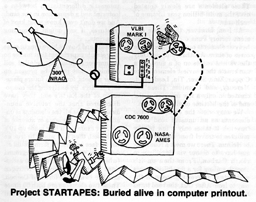 A total of 908 observations have been made so far, distributed over 201 nearby stars, using the 91-meter diameter radiotelescope at the National Radio Astronomy Observatory (NRAO) in Green Bank, West Virginia. Of these, 53 were found to contain unusual signals and were investigated further. Seventeen turned out to be random noise fluctuations, 15 were caused by equipment errors, and 20 were due to interference from terrestrial signals. This left only one unexplained signal. Unfortunately the observations were incomplete for that star, so it was not possible to eliminate
terrestrial interference as the cause of this signal as well.
A total of 908 observations have been made so far, distributed over 201 nearby stars, using the 91-meter diameter radiotelescope at the National Radio Astronomy Observatory (NRAO) in Green Bank, West Virginia. Of these, 53 were found to contain unusual signals and were investigated further. Seventeen turned out to be random noise fluctuations, 15 were caused by equipment errors, and 20 were due to interference from terrestrial signals. This left only one unexplained signal. Unfortunately the observations were incomplete for that star, so it was not possible to eliminate
terrestrial interference as the cause of this signal as well.
The NASA team plans further observations of that one star, as well as many others, using the 300-meter diameter radio telescope in Puerto Rico. The tape recording method has proven successful and valuable observational experience has been obtained. Eventually NASA will construct million or billion channel receivers and data processing systems to acquire and process this kind of data continuously in real time. Until then, STARTAPES is the next best thing, despite the drawback of short observational runs followed by long computer runs.
Using Radio Waves to Detect Gravity Waves
One method of detecting gravity waves is to use a large mass that resonates at the frequency of the gravity waves being sought (see ABCs of Space in the Winter 1980 issue of COSMIC SEARCH). An alternative method has been proposed by F. B. Estabrook of the Jet Propulsion Laboratory.* (*Presented at the Congress of the International Astronautical Federation in Dubrovnik, Yugoslavia, October, 1978.)
The method involves transmitting a radio signal from Earth to an interplanetary satellite, and using a repeater transmitter on the satellite to immediately retransmit the signal back to Earth, incurring a total round-trip delay of some time interval we may designate as T. The frequency of the radio signal used is immaterial, but T must be measured with utmost accuracy. If T is varying with time (implying that the satellite has a component of velocity toward or away from the Earth), the frequency of the returned radio signal will be changed (Doppler shifted) slightly. Since inter-planetary satellites are far away and move slowly, they change their velocity relative to Earth only very slowly. Thus, we can regard the Doppler shift caused by the motion of the satellite to be approximately constant with time.
If a passing gravity wave engulfs the Earth and the satellite, it will cause an additional Doppler shift to occur. The normally constant Doppler shift will exhibit sinusoidal fluctuations about its normal value. The motion-caused Doppler shift may be regarded as the "direct-current" or DC component and the gravity-wave-caused Doppler shift as the "alternating-current" or AC component. Another way of looking at it is to regard the motion-caused Doppler shift as analogous to a radio wave "carrier," and the gravity-wave-caused shift as a "frequency modulation". It is very important to understand, however, that the motion-caused Doppler shift must be present before a gravity wave can cause additional Doppler shift. This is analogous to the fact that a radio carrier must be present, in order for it to be frequency modulated.
The gravity wave Doppler shift has two different sinusoidal components. The higher frequency component occurs at the frequency of the gravity wave itself. Its amplitude is maximum when the radio wave is perpendicular to the gravity wave, and is zero when they are parallel. 1 (1The high frequency component is proportional to sin(2πfgT), where fg is the frequency of the gravity wave.) The lower frequency component has a frequency that depends on the angle of intersection between the radio and gravity waves.2 (2The low frequency component is proportional to sin(1-cosθ)2πfgT, where theta (θ) is the angle between the direction of the two waves. In all cases, the amplitude of the extra Doppler shift is proportional to the strength of the gravity wave.) When the waves are perpendicular, the frequency is the same as the gravity wave and its amplitude is minimum. When the waves are parallel, the frequency is zero and the amplitude is maximum.
This latter case (which occurs when the satellite is in exactly the same or opposite direction to the gravity wave) is not useful, since a zero-frequency sinusoid whose initial value is zero will have a zero value for all finite times. Thus, gravity waves in those two directions cannot be detected by this method.
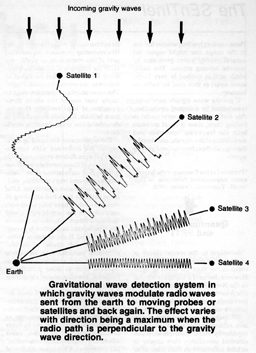 These effects are illustrated in the diagram. The gravity-wave-caused Doppler shift as a function of the delay time T is shown for four different satellites in various directions. The frequency of an incoming gravity wave can be determined from the high-frequency wiggles in the Doppler shift curve, and the arrival direction of the gravity wave can be determined from the low-frequency wiggles. Thus, the method is very general in application.
These effects are illustrated in the diagram. The gravity-wave-caused Doppler shift as a function of the delay time T is shown for four different satellites in various directions. The frequency of an incoming gravity wave can be determined from the high-frequency wiggles in the Doppler shift curve, and the arrival direction of the gravity wave can be determined from the low-frequency wiggles. Thus, the method is very general in application.
One of the practical difficulties in applying the method is that there are diffuse plasma clouds floating around in space, and when a satellite goes through or behind one, a Doppler shift is introduced which tends to mask that caused by gravity waves. This effect can be overcome by using two or more satellites simultaneously, since they could not all be influenced by the same plasma cloud. Another reason for having as many satellites as possible is that their Doppler waveforms can be intercompared and averaged to detect weaker signals, or to sort out gravity waves arriving from several different sources simultaneously.
The frequency range of gravity waves that can be detected by this method is limited by current technology to between 0.0001 and 0.1 hertz. These are very low frequencies but are in the range one might expect for natural gravity waves generated by massive moving objects. The bandwidth of this method is very large, about equal to that used for radio astronomy.
If gravity wave signals were being transmitted by a distant civilization, this method would be very useful in finding them, since it could measure both the frequency spectrum and modulation of the signals, and thereby distinguish them from natural gravity waves.
Quantum Theory and SETI*
(*Contributed by David Raub.)
According to the special theory of relativity, no signal or influence can travel faster than the speed of light. However, Bernard d'Espagnat writing in the November 1979 issue of Scientific American described a series of experiments in which this basic tenet of modern science seems to be violated. D'Espagnat explained that if certain subatomic particles are brought together by well-defined quantum mechanical procedures, they appear to exhibit influences on each other after
they are separated again, with the influences occurring at superluminal (faster-than-light) speeds. In fact, five out of seven experiments conducted since 1972 point in the direction of this phenomenon.
Recent insights in the field of quantum physics seem to say that results derived from experiments conducted in a quantum mechanical context are in conflict with what d'Espagnat calls local realistic theories of nature.
In short, d'Espagnat's theories are basically "common-sense" viewpoints that (1) take the existence of an independent external reality for granted. This external reality, although independent of the observer, can be known through human sensory perceptions and (2) logical conclusions regarding its nature can be made through inductive reasoning processes. An essential part of this common-sense world view is (3) the principle of Einstein reparability which states that no signal or influence can exceed the speed of light. The experiments in question seem to imply that one of the above three
premises of local realistic theories must be false. Einstein separability is considered the most plausible candidate.
The experiments discussed by d'Espagnat are concerned with correlations between distant events and with the causes of those correlations. These unexplained correlations show themselves in several ways involving various kinds of subatomic particles. All of these particles have had one thing in common — they have interacted with each other in the past in such a way that their future behavior in terms of the experiments in question is permanently altered. It also makes no difference how far these quantum-correlated particles may ultimately separate as long as no perturbing influences, such as other particles or radiation, are encountered along their paths.
In the preponderance of tests described by d'Espagnat, this past correlation relationship reveals itself in future experimental measurements as an influence which appears to occur instantaneously. In those cases where this "superluminal connection" did not appear, d'Espagnat attributed it to basic systemic flaws in the designs of the experiments themselves.
If future tests prove with certainty that this effect occurs instantaneously, does this mean that the principle of the finite propagation time of signals must be abandoned? According to d'Espagnat and most other physicists, the answer is no. In their view, these influences could not be utilized to transmit any useful information or signals, as can be done with electromagnetic radiation.
It should be noted, however, that this view is not unanimously held by all physicists. Dr. Jack Sarfatti, formerly of San Diego State University, and Dr. Nick Herbert, Director of the C-Life Institute in California, have both been working on theoretical schemes which purportedly could use these quantum correlated effects to transmit information instantaneously to any place in space and time regardless of distance. Although neither Sarfatti nor Herbert has achieved success thus far in these experiments, nor do they have much acceptance from the scientific community for attempting to prove the validity of their schemes, this controversy does show that the issue of superluminal propagation of information is not yet completely resolved.
If Sarfatti and Herbert prove to be correct in their revolutionary ideas, it would have a large impact on the Search for Intelligent Life in the Universe.
Bumper Science
I dig archeology
Astronomy is looking up
Astronomers follow heavenly bodies
Botany is leafing out
I nose my way around in chemistry
Cryogenics is real cool
Electronics gives me a charge
Geology is on the rocks
Mathematics is a numbers game
Get with the current, be an oceanographer
Meteorology is in the air
Physics is good for you
Space is far out
|
Miscellaneous Items
Webpage Table of Contents (Bookmarks)
(Internal links to categories of items in this webpage)
Information About the Publication
(Editorial Board, Editors, Table of Contents)

Editors, and Others Involved in the Publication
Editor: John Kraus, Director, Ohio State University Radio Observatory.
Co-Editor: Mirjana R. Gearhart, Research Astronomer, Ohio State University Radio Observatory.
Co-Editor: Robert S. Dixon, Assistant Director, Ohio State University Radio Observatory
Business Manager: Sylvia Raub
Controller: Lesly Arnold
Assistants: David Raub, Norman Gearhart, Alice Kraus, Harold DeVries, Ann Cole, Janice Kraus, Richard Arnold, Wendy McKenna, Jerry Ehman, Elsa Damon
Editorial Board
- Richard Berendzen, President, The American University
- John Billingham, Director SETI Program, NASA-AMES Research Center
- Ronald Bracewell, Director, Radio Astronomy Observatory, Stanford University
- Thomas A. Clark, NASA-Goddard Space Flight Center
- Arthur C. Clarke, Sri Lanka, author of "2001, A Space Odyssey"
- Norman Cousins, Chairman, Editorial Board, SATURDAY REVIEW
- Frank D. Drake, Director, National Astronomy and Ionosphere Center (Arecibo), Cornell University
- Robert E. Edelson, SETI Project Manager, Jet Propulsion Laboratory, California Institute of Technology
- Donald S. Hall, Director, Strasenburgh Planetarium, Rochester, New York; Past President, International Planetarium Society
- Theodore M. Hesburgh, President, University of Notre Dame
- Nikolai Kardashev, Space Research Institute, Academy of Sciences, Moscow, USSR
- Philip Morrison, Physics Department, Massachusetts Institute of Technology
- Bernard Oliver, Vice President, Hewlett-Packard Company; Director of NASA-Ames Cyclops Project
- Cyril Ponnamperuma, Director, Laboratory of Chemical Evolution, University of Maryland
- Martin Rees, Director, Institute of Astronomy, Cambridge University, England
- Carl Sagan, Director, Laboratory for Planetary Studies, Cornell University
- Walter Sullivan, Science Editor, New York Times
- Vasevolod S. Troitsky, Radiophysical Scientific Research Institute, Gorky, USSR
- Sebastian von Hoerner, National Radio Astronomy Observatory
About COSMIC SEARCH
COSMIC SEARCH is published quarterly (Winter: Jan.-Feb.-Mar.;Spring: Apr.-May-June; Summer: July-Aug.-Sept.; Fall: Oct.-Nov.-Dec.) by Cosmic-Quest, Inc. Copyright © 1980 by Cosmic-Quest, Inc. All rights reserved.
Cosmic Quest, Inc., is a non-profit educational-scientific (tax-exempt) organization.
Subscription price: $10 for 4 issues in U.S. (and possessions), $13 elsewhere. Single copies: $2.50 in U.S. (and possessions), $3 elsewhere.
Address subscriptions and all other correspondence to: Radio Observatory, Box 293, Delaware, Ohio 43015.
Second-class postage is paid at Delaware, Ohio, and at additional mailing offices.
Telephone: (614) 486-8488
Opinions expressed by persons writing in COSMIC SEARCH are their own and do not necessarily reflect the opinions of the editorial staff.
To ALL COSMIC SEARCHers
[This statement was found on page 25 of the magazine.]
Our goal is to create a popular, responsible magazine taking you to the exciting frontiers of science with a sense of great
adventures to come:
• a magazine about space, the future and the search for intelligent life in the universe—
• a magazine which can be read with understanding by a high school student and with profit by a Ph.D.
With the emminent background and wide experience of our editorial board and our authors we are working to achieve these
objectives. The problems of starting such a magazine,, however, are formidable and although we are making progress we
believe you might like to know more about the story behind COSMIC SEARCH.
During 1977 a group of us associated with the Ohio State University Radio Observatory formed an independent, non-profit scientific-educational organization, Cosmic-Quest, Inc., with the purpose of publishing COSMIC SEARCH.
We were all very naive, rank amateurs with no experience in magazine publishing and we grossly underestimated the complexity of the magazine business and the work involved. But we learned rapidly and found many veteran magazine people who were willing to share their expertise. At this point everyone connected with the magazine was an unpaid volunteer.
Whereas many new magazines are launched with investments of hundreds of thousands to millions of dollars, our starting capital was a $40,000 loan. To generate subscriptions $10,000 was spent for ads in magazines. The resulting cost per subscription ranged from $3 in the case of the best magazine to over $30 for some others. If a subscription cost over $4 we were losing money.
As we went to press for the premier issue we had about 1000 subscribers but we printed 75,000 copies at a cost of $25,500
and mailed nearly 65,000 as complimentary copies to generate subscriptions. Results were less than we had hoped, amounting to about a 2 percent response.
Our original intent was to publish 6 issues a year. Although sufficient manuscripts were no problem, editing and publishing
at this frequency was more than a small volunteer group could handle so we went to 4 issues a year but giving all previous
subscribers 6 issues for a one year subscription.
For the next three issues we printed an average of 10,000 copies per issue at an average cost of $6500 per issue. In addition to printing costs, we had big bills for postage, envelopes, office supplies, telephone, legal fees and many other items totalling nearly $20,000. Income from advertisements in the magazine had netted only a few hundred dollars and with new subscriptions levelling off we had not on only a debt of $40,000 (loan) but we were losing about $2000 a month.
Currently we have about 4000 subscribers and a newsstand distribution of about 5000. Production cost per copy drops dramatically as the number printed goes over 10,000. We need at least double the present number of subscribers and newsstand sales to make COSMIC SEARCH a self-sustaining operation. Although there is now one part-time hourly employee,
Sylvia Raub, our efficient Business Manager, the rest of the effort is completely volunteer with much of the work done on
kitchen tables, literally. Initially we hoped some magazine income over expenses could be used to assist deserving research projects but these visions have vanished and all we now want to do is break even.
Although the work is staggering, we enjoy doing it and with the encouragement of our readers we intend to continue.
John Kraus
Front Cover
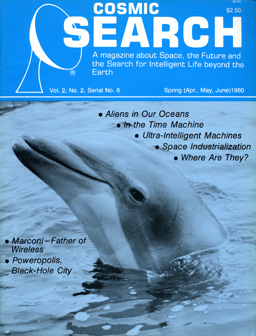
Smiling dolphin. Does his smirk indicate he knows something we don't? See article by Bruce Fleury. Photo from David K.
Caldwell, Biological Systems, Inc.
Table of Contents (in magazine)
| Item | Pg |
|---|
The Aliens in Our Oceans: Dolphins as Analogs
Studies of dolphins may help us understand the problems of communicating with alien civilizations.
By Bruce E. Fleury | 2 |
|---|
Marconi
Some reflections on a great pioneer.
By George H. Brown | 6 |
|---|
The Chief Entities
From angels and devils to ultra-intelligent machines.
By I. J. Good | 13 |
|---|
| Scientists debate the prospects of Life in the Universe at three separate conferences: | |
|---|
Communication with Extraterrestrial Intelligence (Munich, West Germany)
By Jill Tarter | 18 |
|---|
Life in the Universe (Paris, France)
By Jill Tarter | 19 |
|---|
Where Are They? (College Park, Maryland)
By Virginia Trimble | 20 |
|---|
Space Industrialization: Opportunity for Space Science
We are at a critical point. Will we remain shackled to Earth, or will we expand into Space?
By G. Harry Stine | 26 |
|---|
In the Time Machine
When you look at the night sky, you are looking into a time machine.
By Don Lago | 30 |
|---|
Allocating the Radio Spectrum (Geneva, Switzerland)
The radio spectrum is reassigned at a world conference.
By Vernon Pankonin | 40 |
|---|
| Features | |
|---|
| Coming in COSMIC SEARCH | 8 |
|---|
| Letters | 9 |
|---|
| Editorial | 10 |
|---|
| The Adventures of Freddy Seti | 10 |
|---|
| Space Happenings | 11 |
|---|
| Off the Shelf | 12 |
|---|
| In Review | 17 |
|---|
| To All Cosmic Searchers | 25 |
|---|
| Thank You to Donors | 25 |
|---|
| ABCs of Space | 32 |
|---|
| College Courses | 38 |
|---|
| Advertiser's Index | 39 |
|---|
| The SenTInel (SETI News) | 44 |
|---|
|
THANK YOU!
COSMIC SEARCH expresses sincere thanks to the following donors who are helping to make sure that the story of SETI and mankind's future continue to be told in an interesting and factual way.
Planetary Donors
Jane L. Brooks, Adelaide, South Australia (2 years)
David M. Laida, Sierra Vista, Arizona
Arthur J. Morgan, New York, New York
A. V. Shaver, Winchester, Virginia
Paul Simons, Sheboygan, Wisconsin
Dennis Wildfogel, Pomona, New Jersey
COSMIC SEARCH, published by a non-profit scientific-educational organization, has been granted tax-exempt status by the Internal Revenue Service, so contributions are tax-deductible (but subscriptions are not). On a combination donation-subscription or donation-renewal, the amount over and above the magazine cost is tax deductible. For example, if a donor sends $30 (qualifying as a "Planetary Donor") and includes a two-year subscription at $18, the $12 difference is tax-deductible.
Donation categories are as follows:
Planetary: $30 per year
Stellar: $100 per year
Galactic: $500 per year
Cosmic: $1000 per year
Contributions. however, will be gratefully accepted in any amount. Checks should be made payable to Cosmic Quest. Inc., P.O. Box 293, Delaware, Ohio 43015.
|
Coming in COSMIC SEARCH
- "Putting Our Best Signal Forward" by Leonard David
- "Confronting Political Realities" by Marcia S. Smith
- "Space Travel and Life" by E. J. Opik
- "Not as We Know It" by Isaac Asimov
- "Gravity Waves for Interstellar Communication" by David H. Douglass
- "Diana Waves Back: The First Moon Bounce" by John Kraus
- "Strategies of Searching for Extraterrestrial Civilizations" by Nikolai Kardashev
- FORUM: Discussion with Patrick Palmer and Lee Rickart on "SETI Perspectives"
- ABCs of Space will explain in simple terms:
- The Universe in Six Leaps
- The Expanding Universe
- Planetary Rings: The Earth's Ring
- Signals versus Noise
- More SEnTlnel news reports, highlights of meetings, "Off the Shelf" books, college courses and many other special features.
Miscellaneous Quotes
The following quote is not directly associated with any article.
Quote on page 8
Science tells me that each twinkling star
That smiles above us is a peopled sphere,
Or central sun, diffusing light afar;
A link of natures chain ...
Vain is the inquiry-all is darkness, doubt:
This earth is one vast mystery to man.
First find the secrets of this planet out,
Then other planets, other systems scan!
Mikhail Lomonosov from "Evening Meditations on Seeing the Aurora Borealis"
Miscellaneous Graphics
The following graphics are shown on this webpage at a relatively small size; click on each one to obtain a larger size version.
Graphics Entitled: "THE ADVENTURES OF FREDDY SETI" by Su Ark
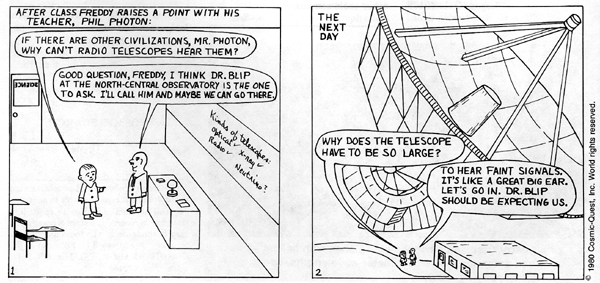
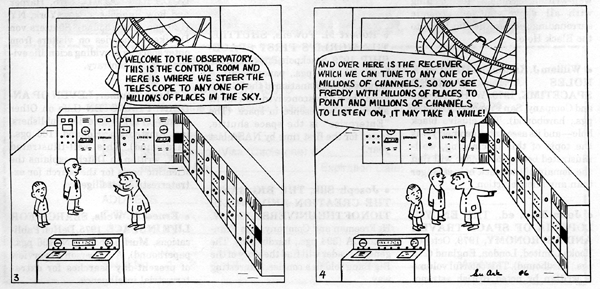
|
![[NAAPO Logo]](../../Images/NAAPOsm.jpg)











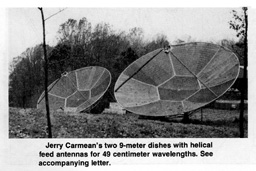



 There is little reason to suppose that all the Top Beings would be of the same species. Even if they were all descended from the same species in the first place, they would have had hundreds of millions of years in which to differentiate into a great variety of species and genera—if these terms are not too geomorphic—by the processes of natural selection and artificial selection. So we can assume, with reasonable confidence, that the United Worlds Organization is sympathetic to all forms of life. Perhaps it would be better to talk about the Chief Entities rather than the Top Beings, since they might be machines, or a hybrid between machines and living beings, "biomachines" as it were. Perhaps biomachines would be more sympathetic to all forms of life than purely biological things would be. A biomachine would probably not be much concerned about the color or even the shape of other biomachines.
There is little reason to suppose that all the Top Beings would be of the same species. Even if they were all descended from the same species in the first place, they would have had hundreds of millions of years in which to differentiate into a great variety of species and genera—if these terms are not too geomorphic—by the processes of natural selection and artificial selection. So we can assume, with reasonable confidence, that the United Worlds Organization is sympathetic to all forms of life. Perhaps it would be better to talk about the Chief Entities rather than the Top Beings, since they might be machines, or a hybrid between machines and living beings, "biomachines" as it were. Perhaps biomachines would be more sympathetic to all forms of life than purely biological things would be. A biomachine would probably not be much concerned about the color or even the shape of other biomachines.











